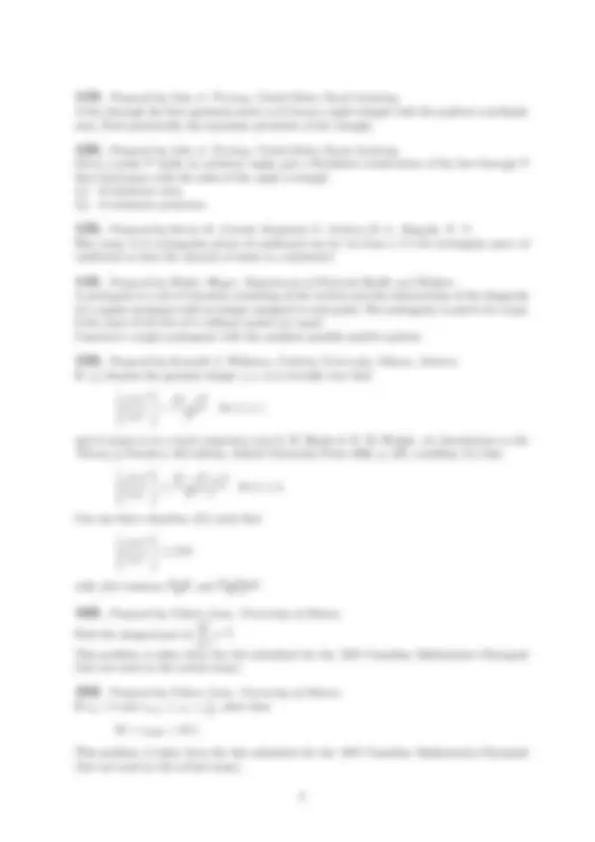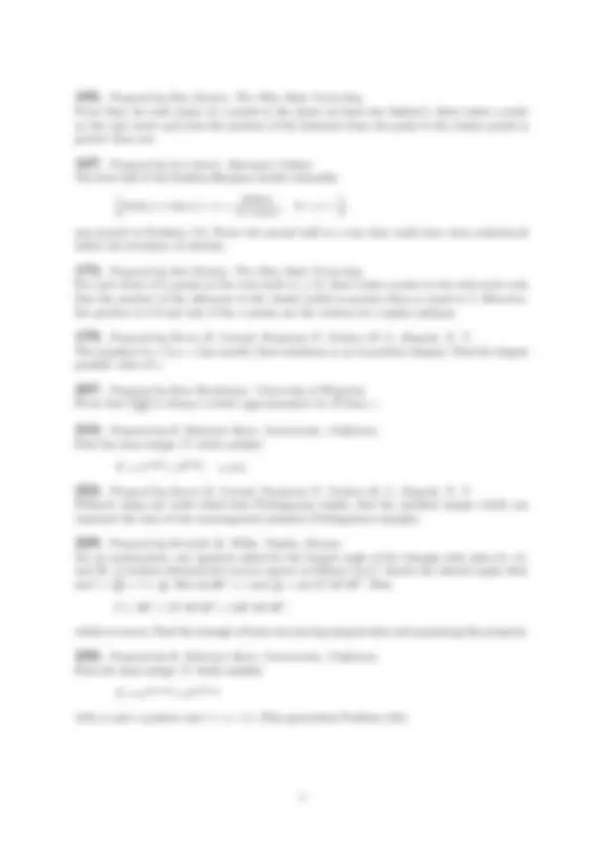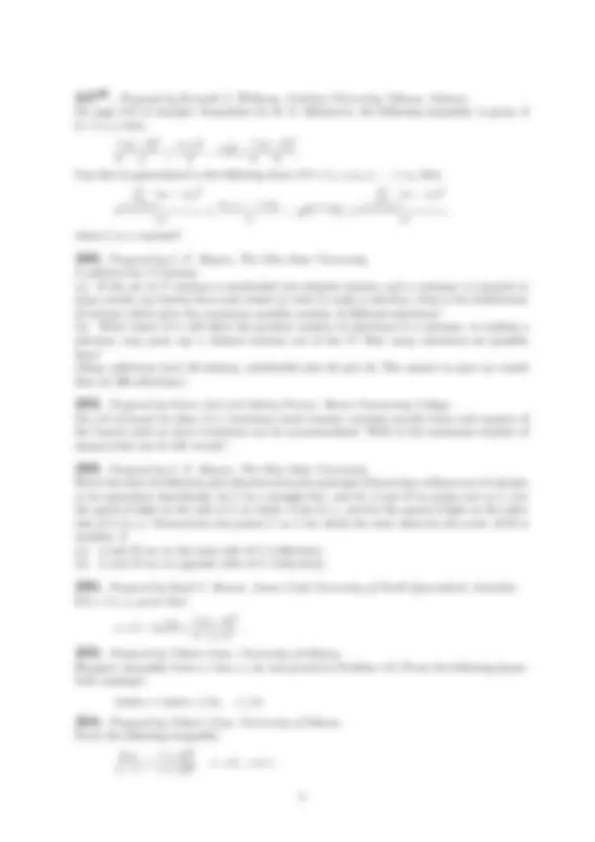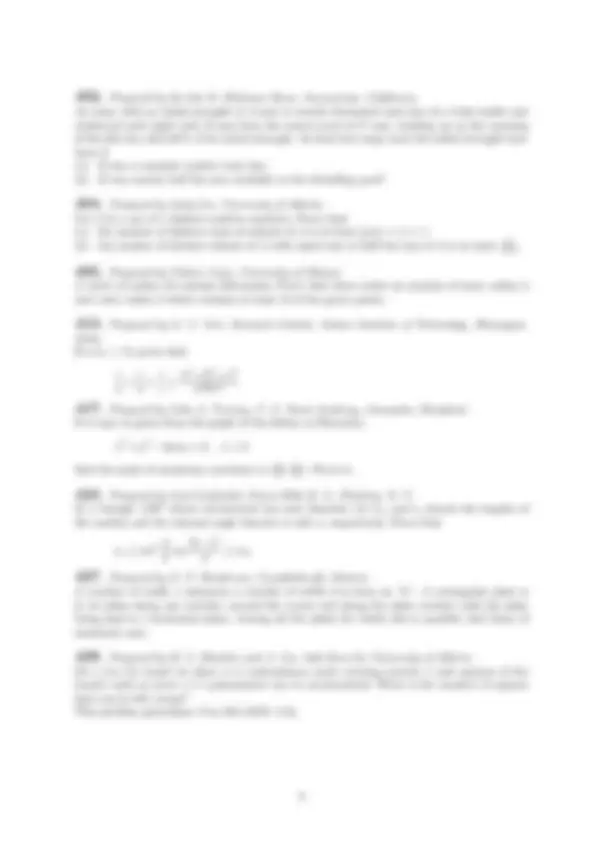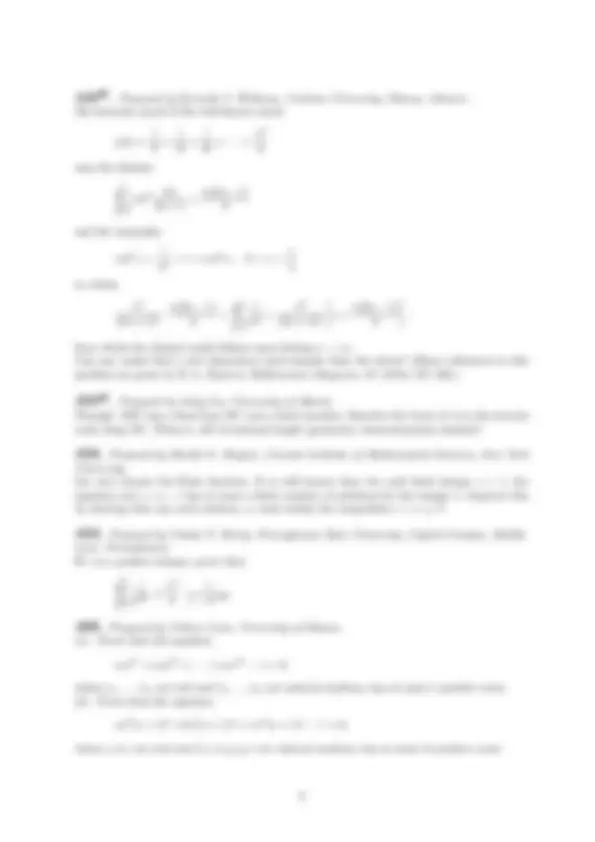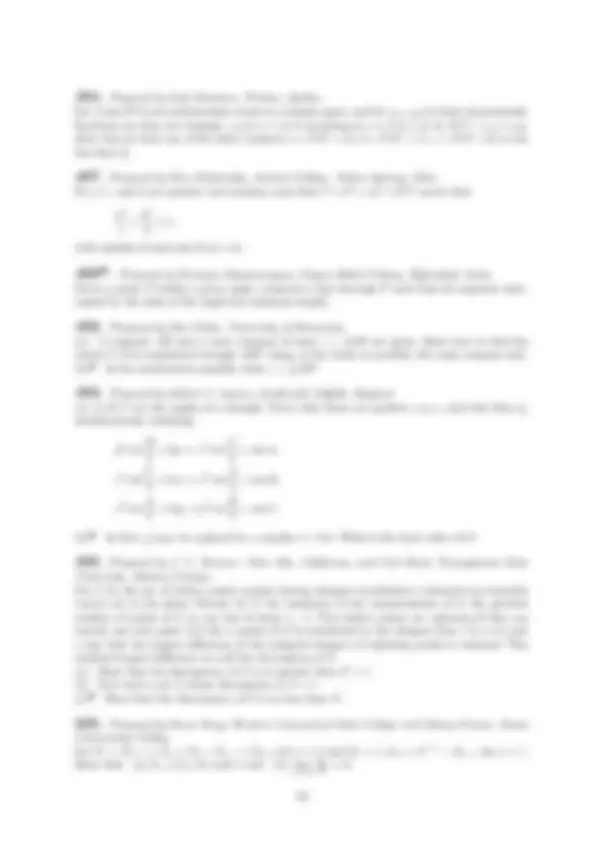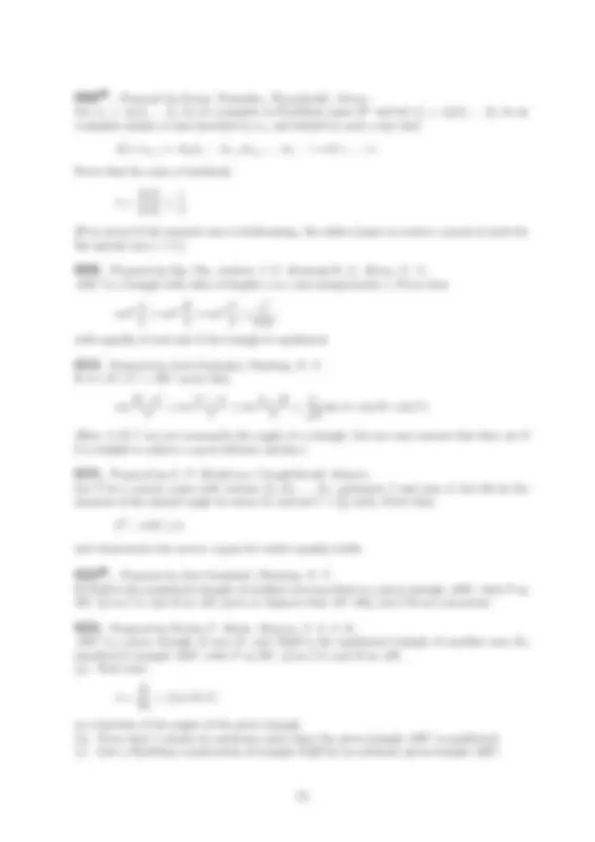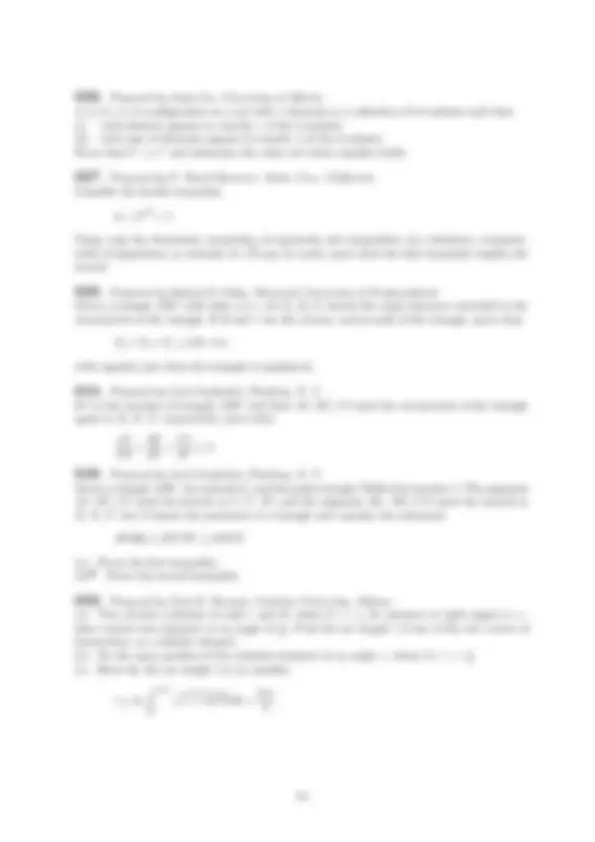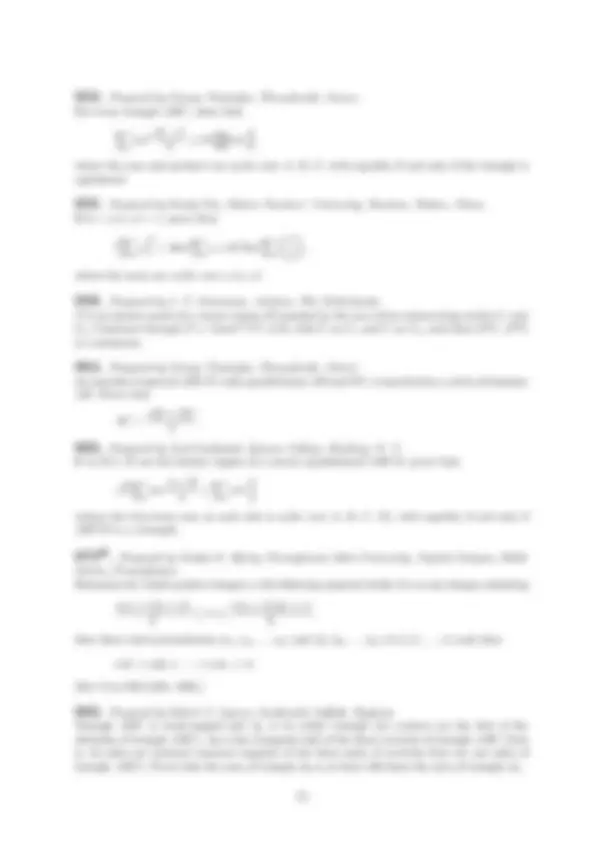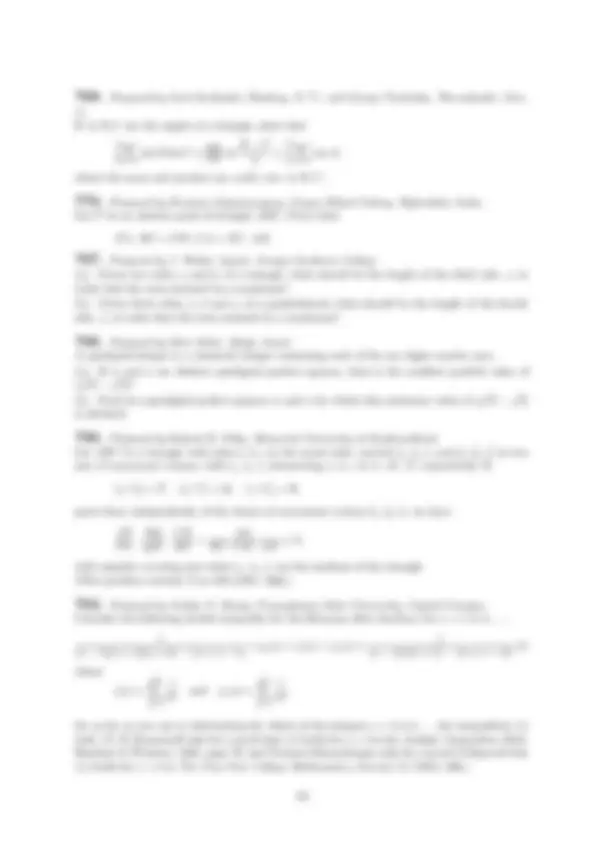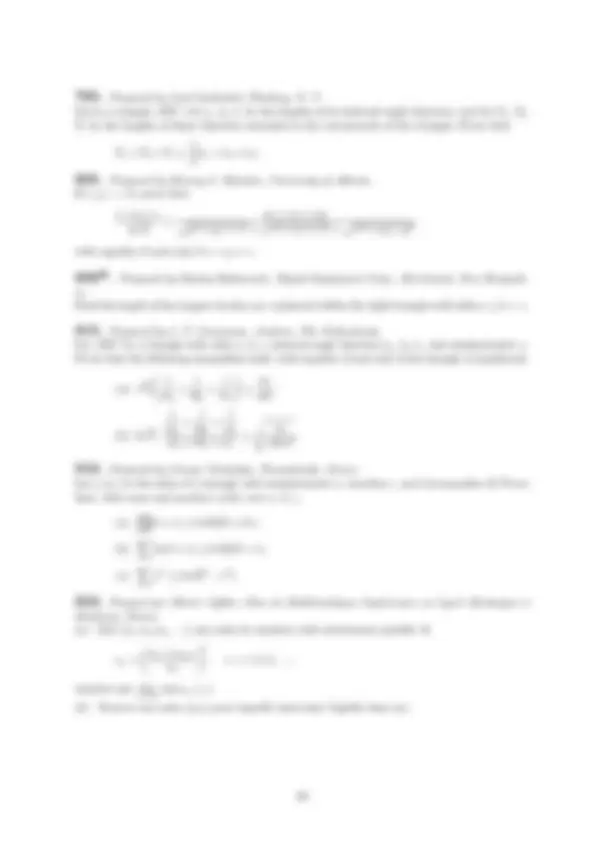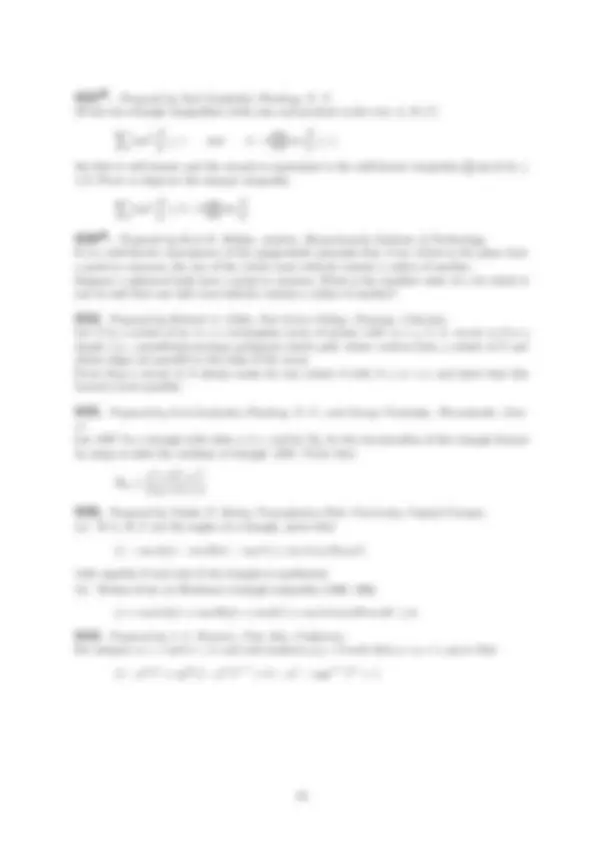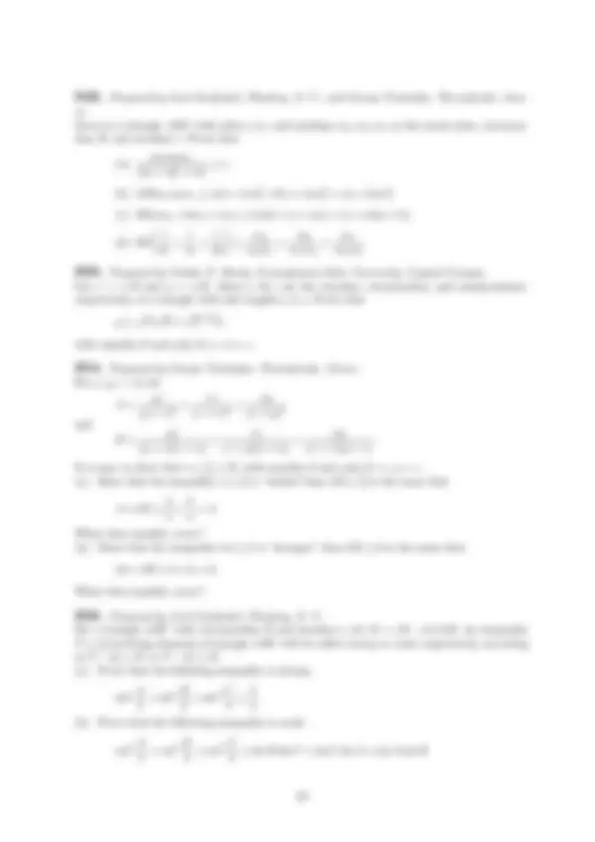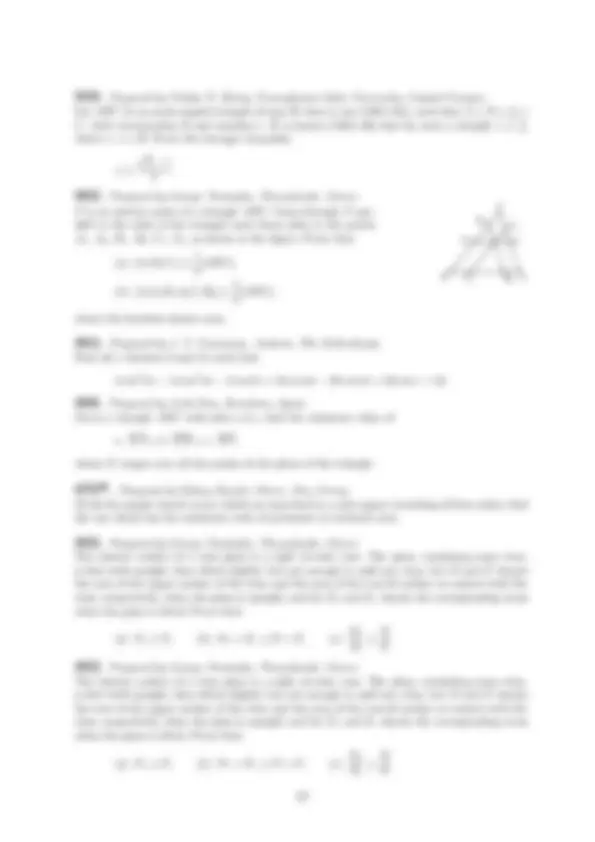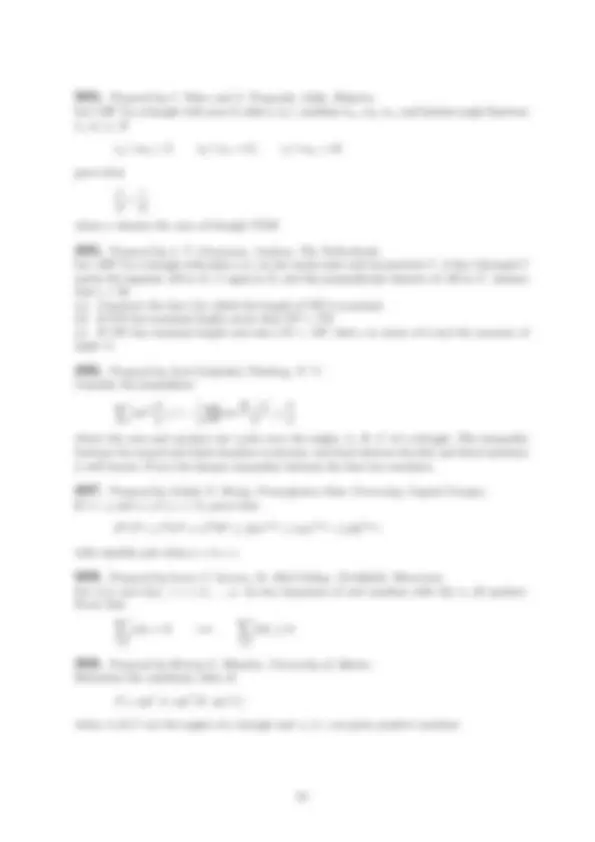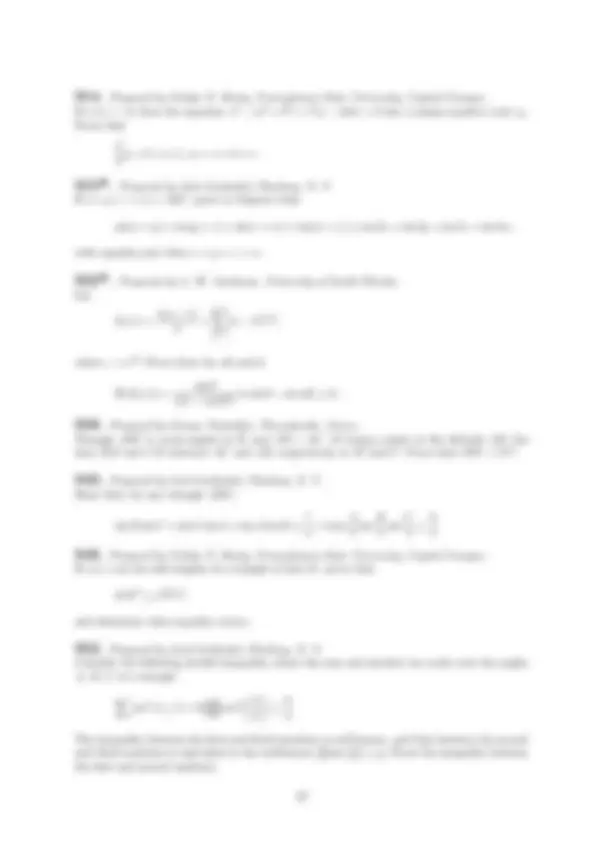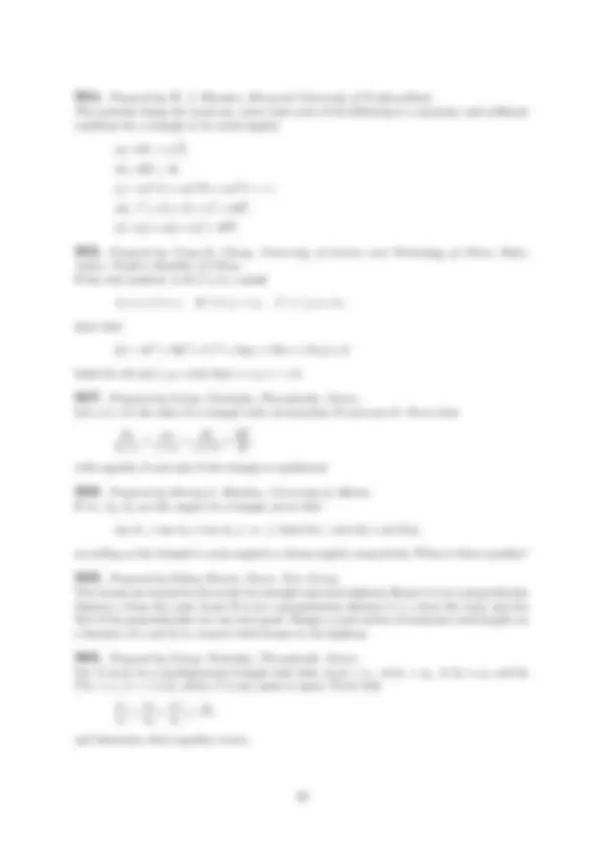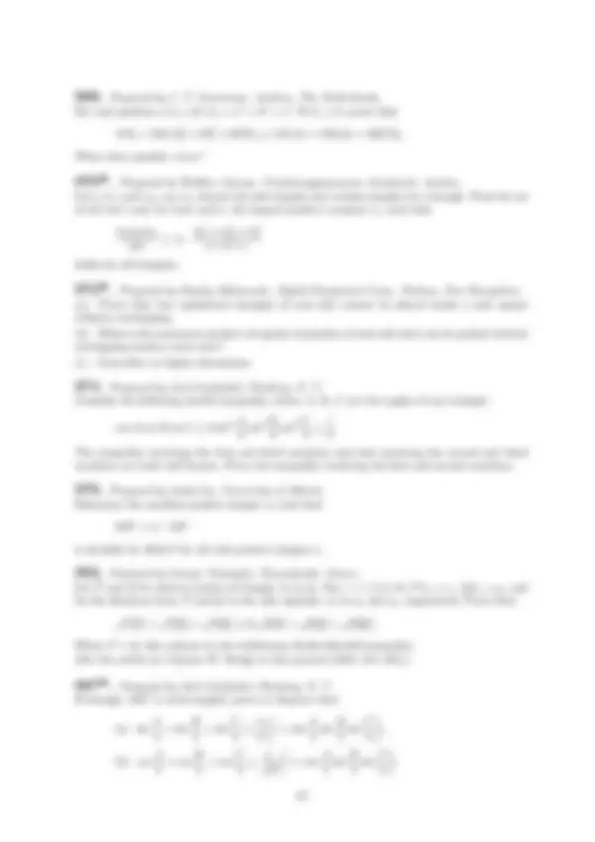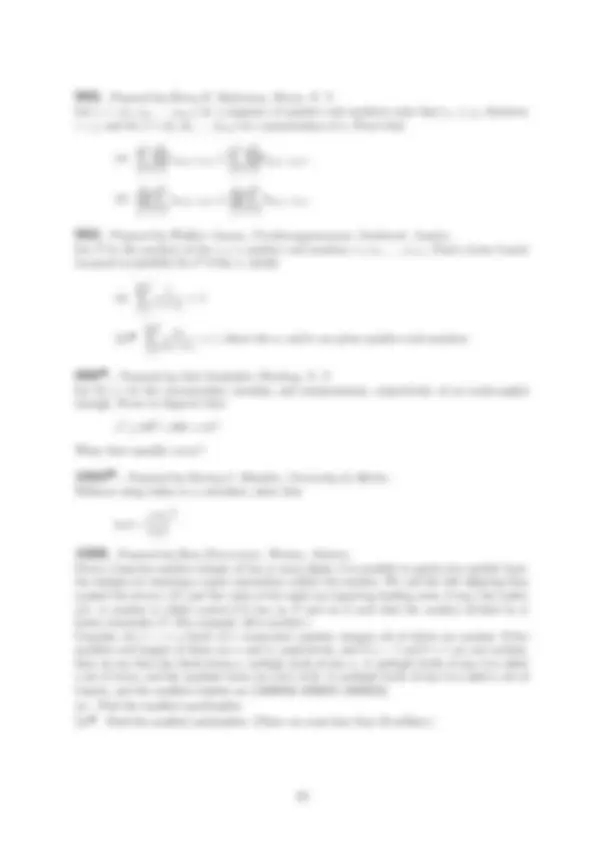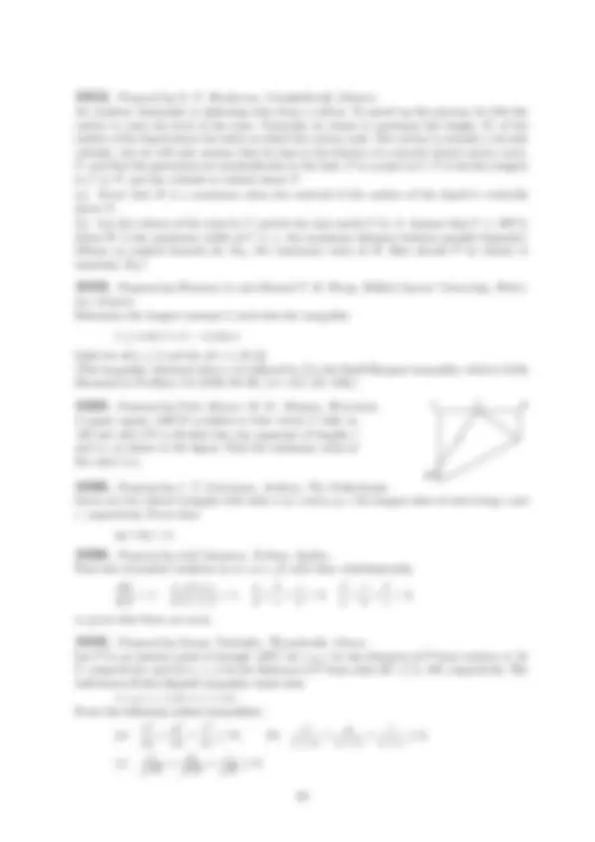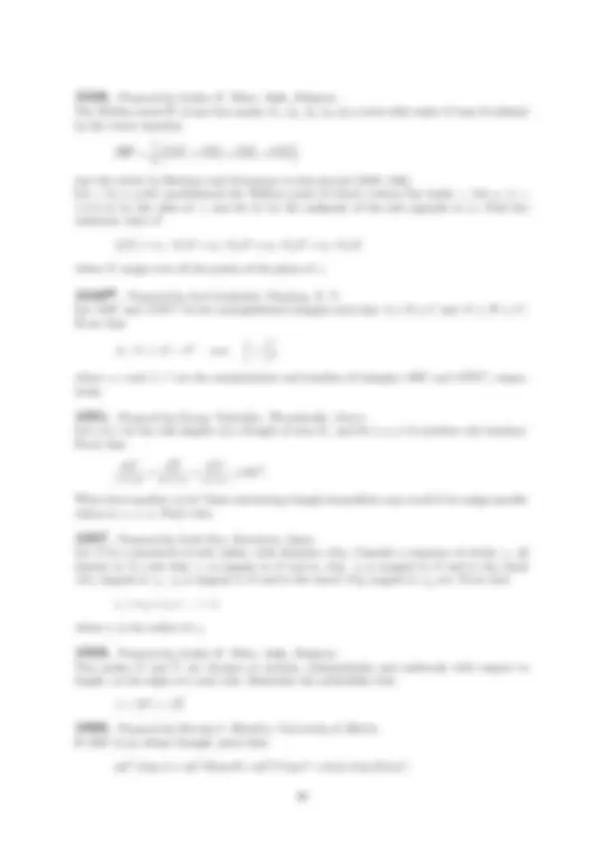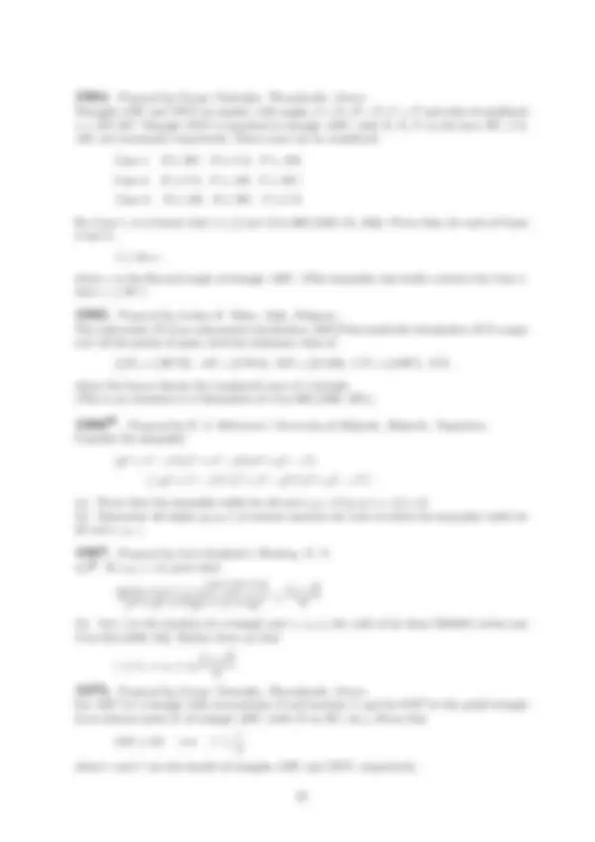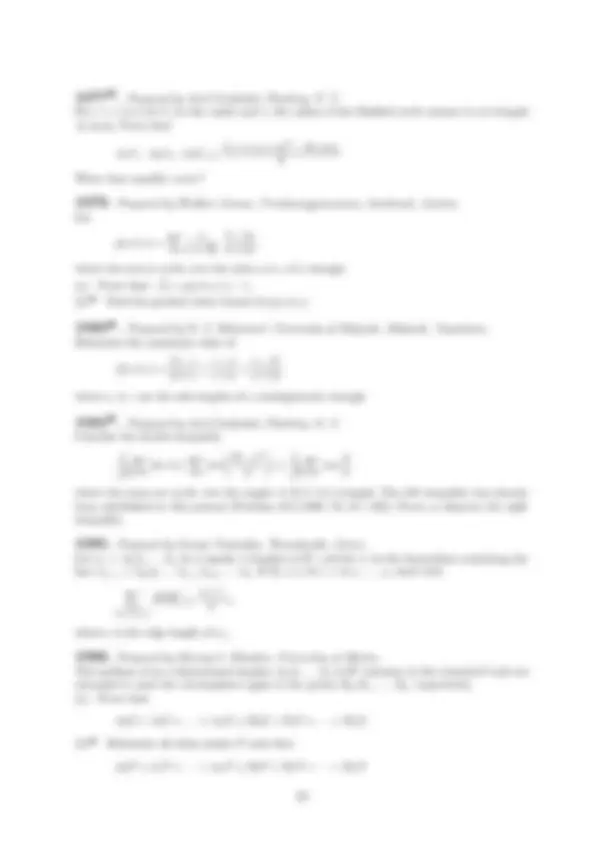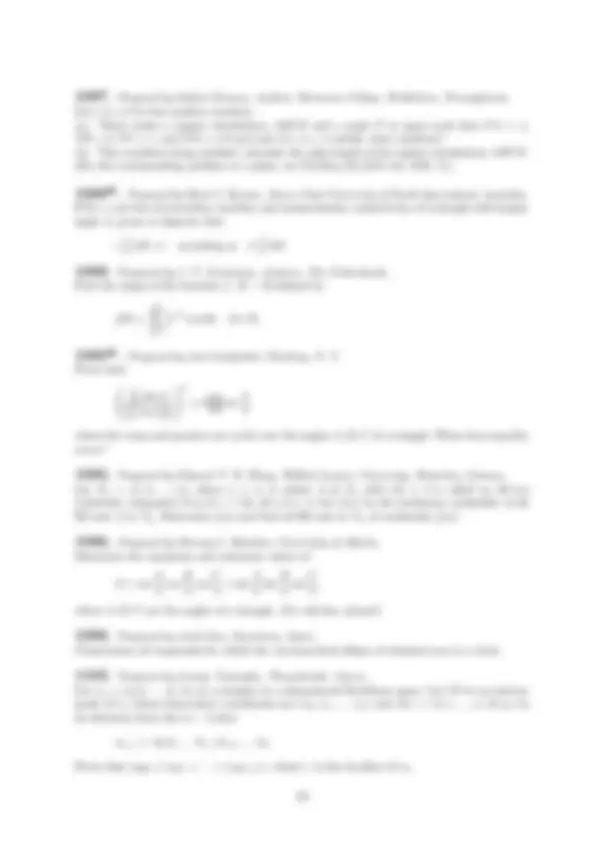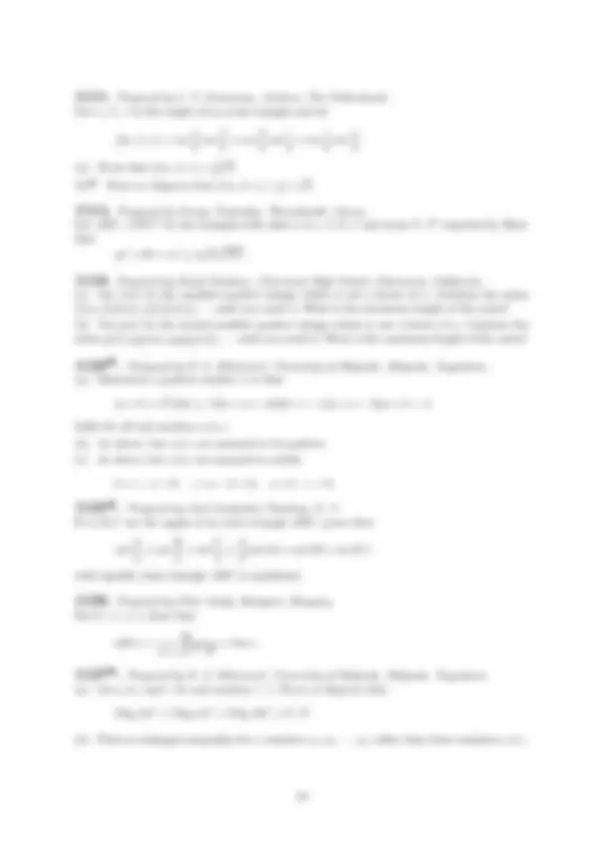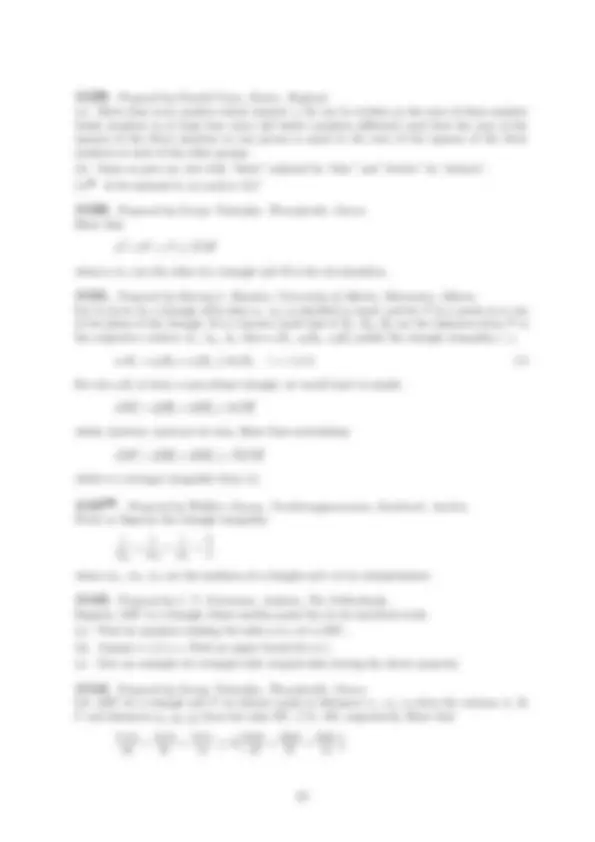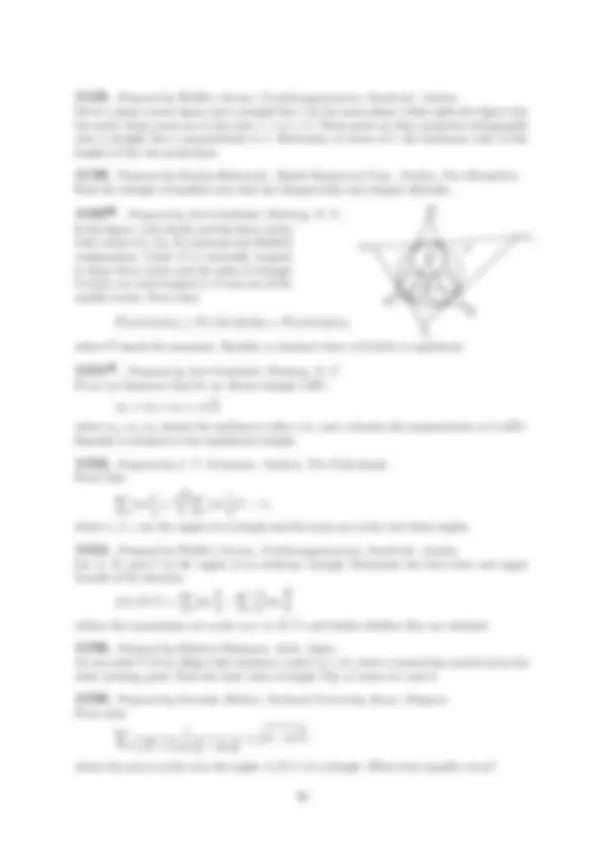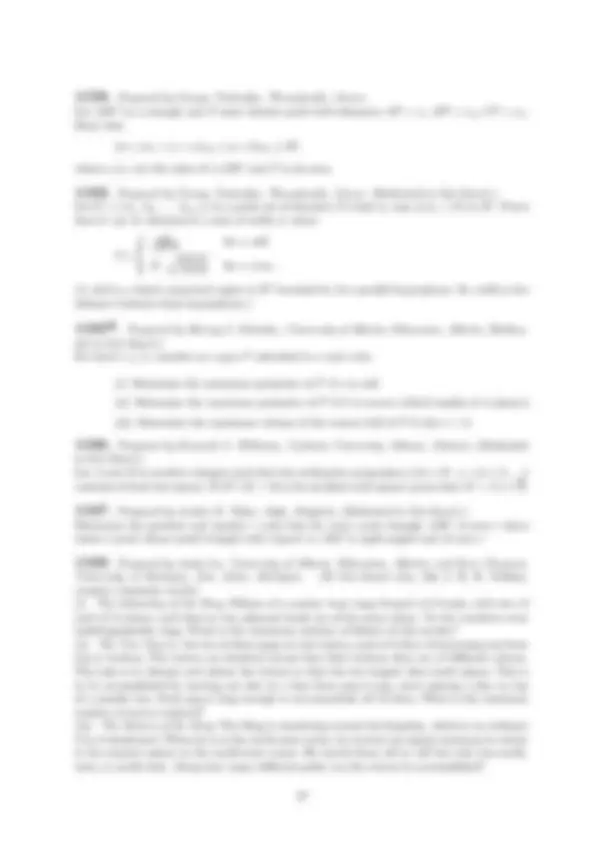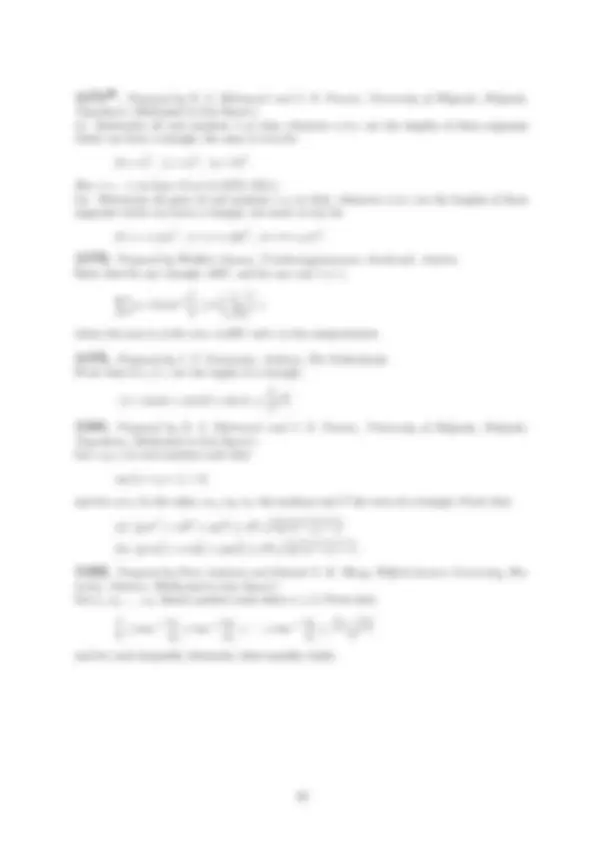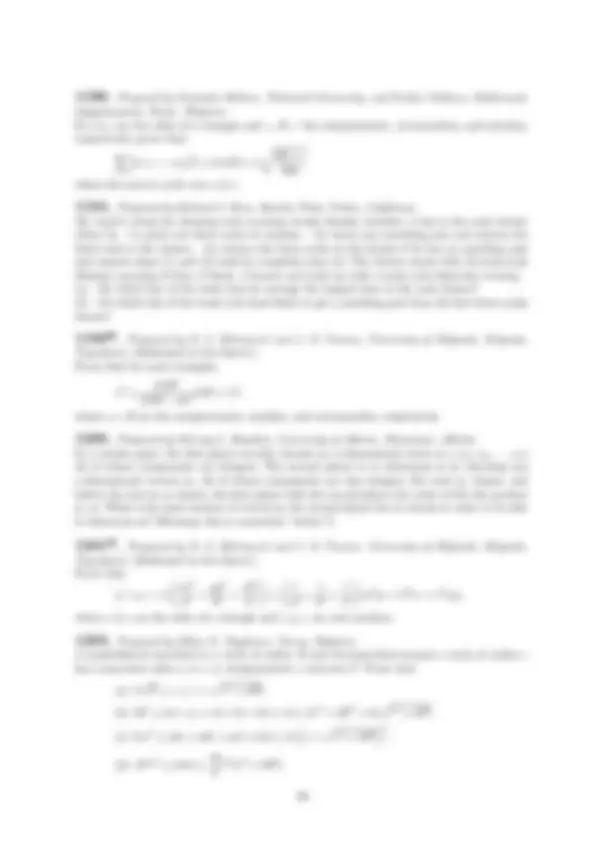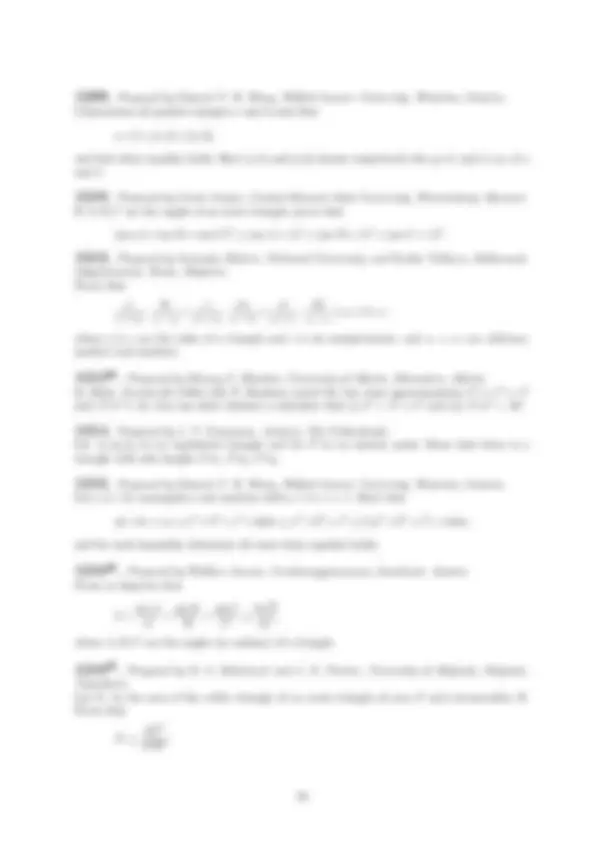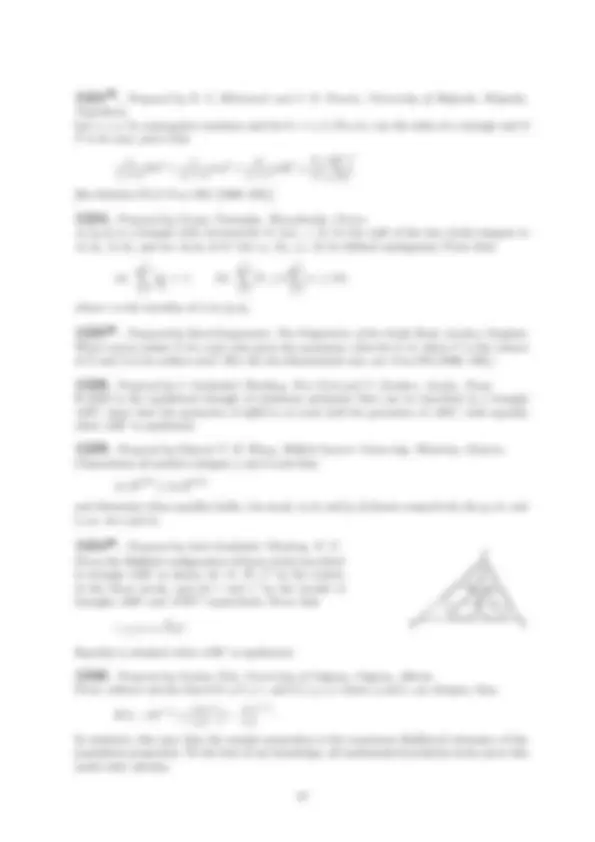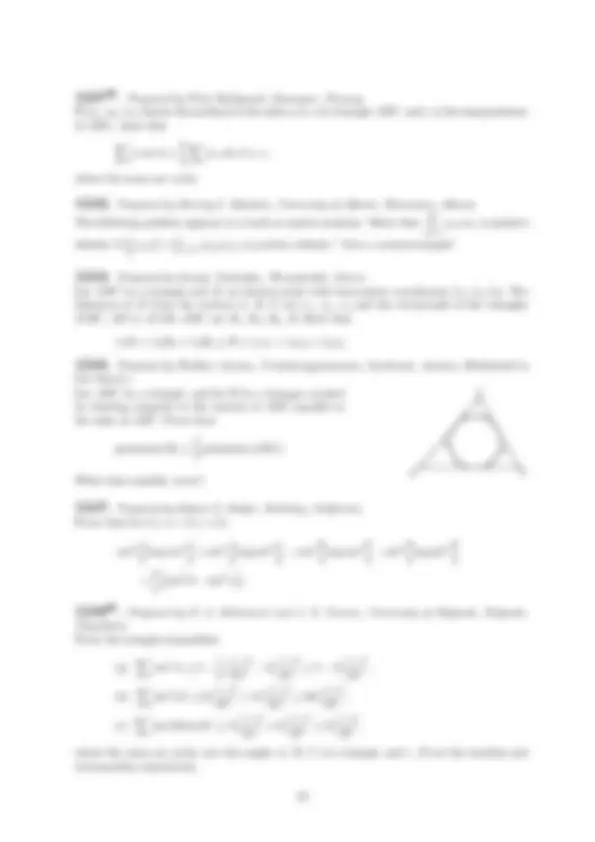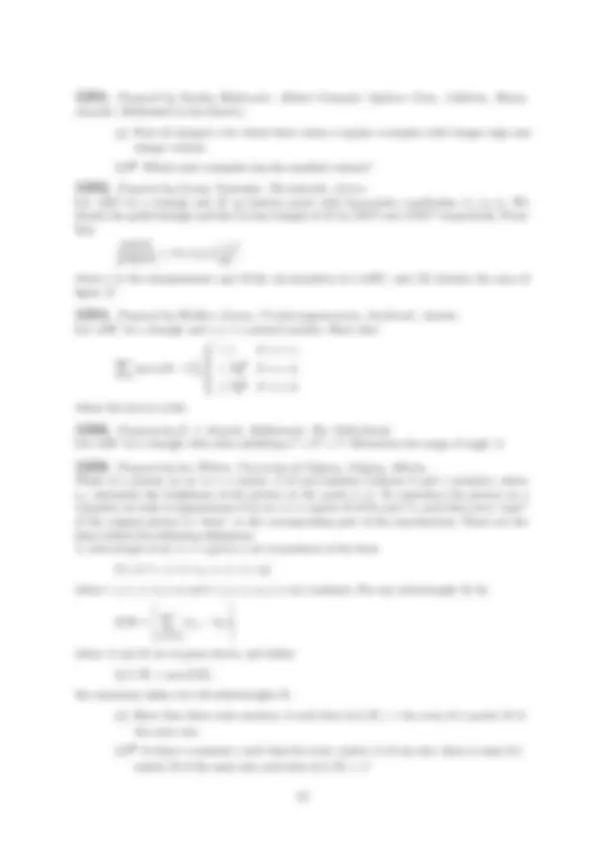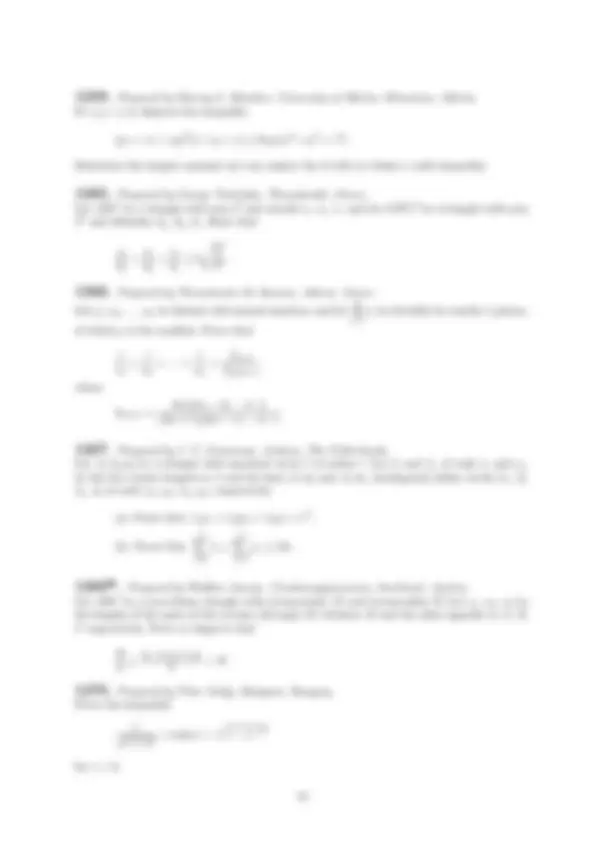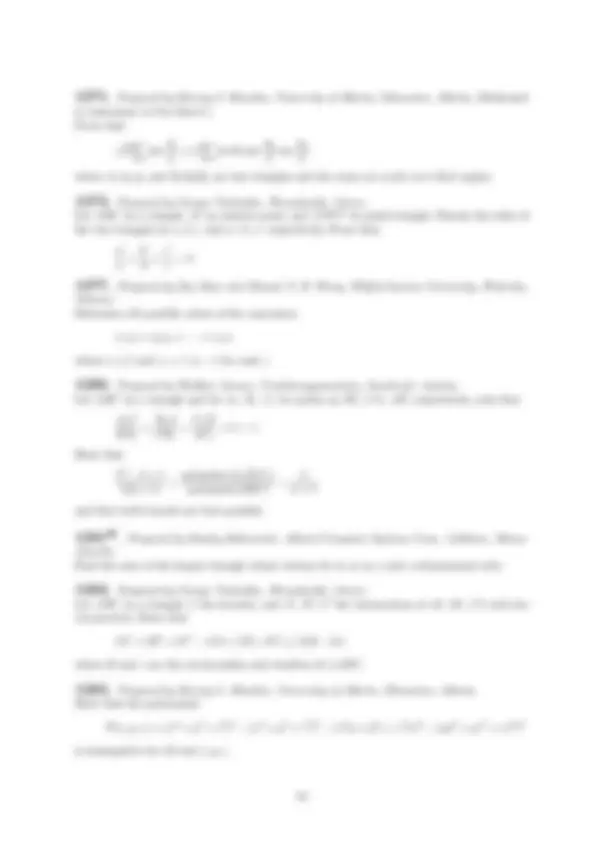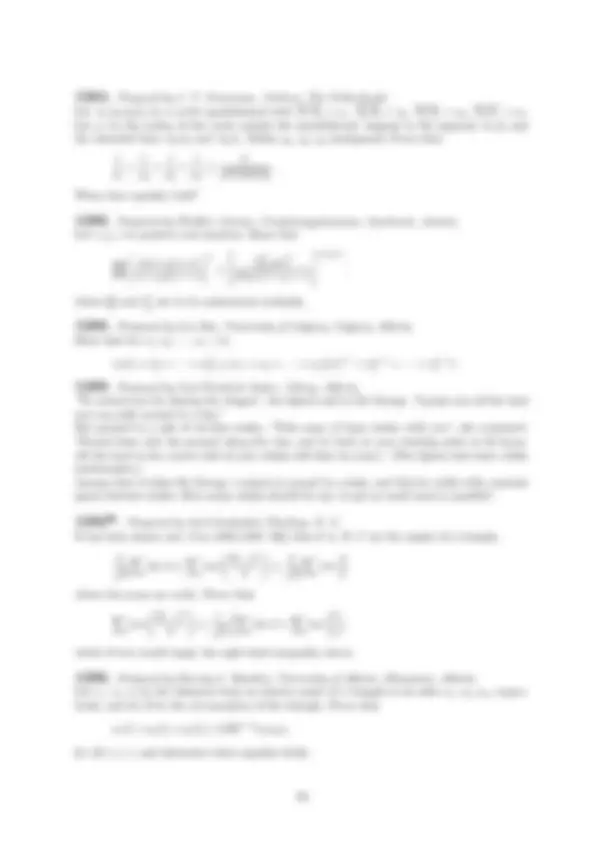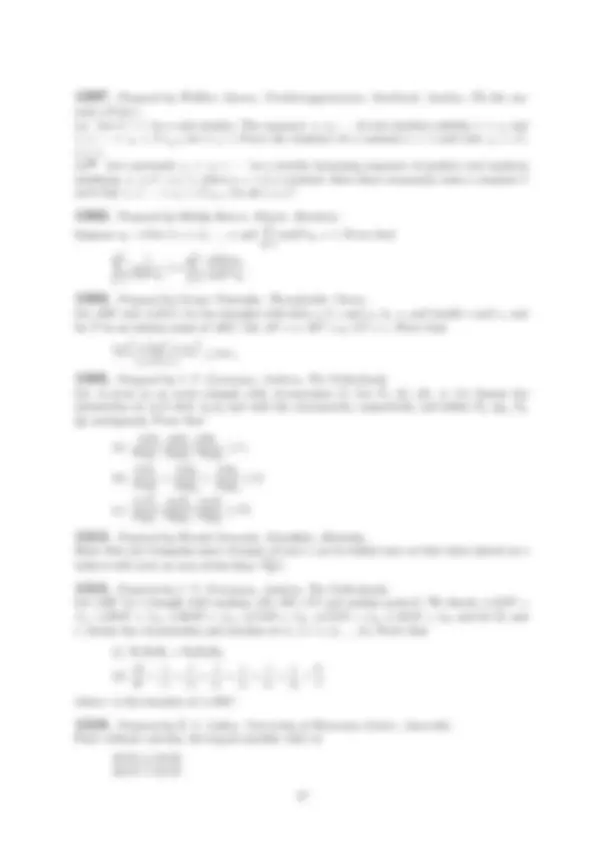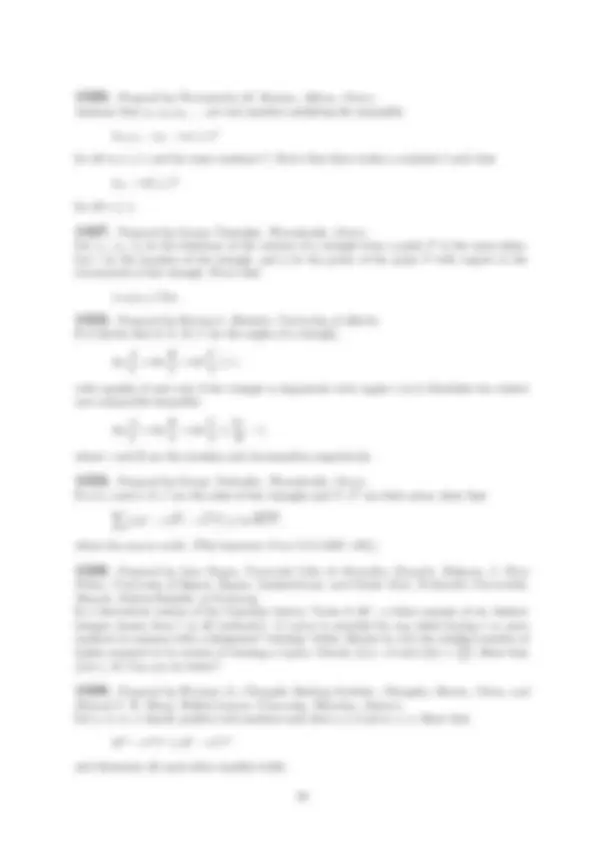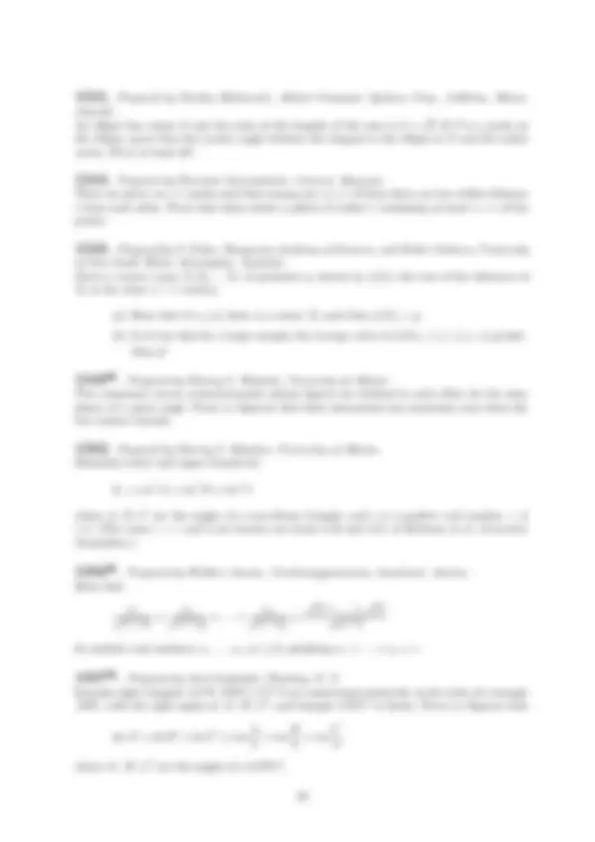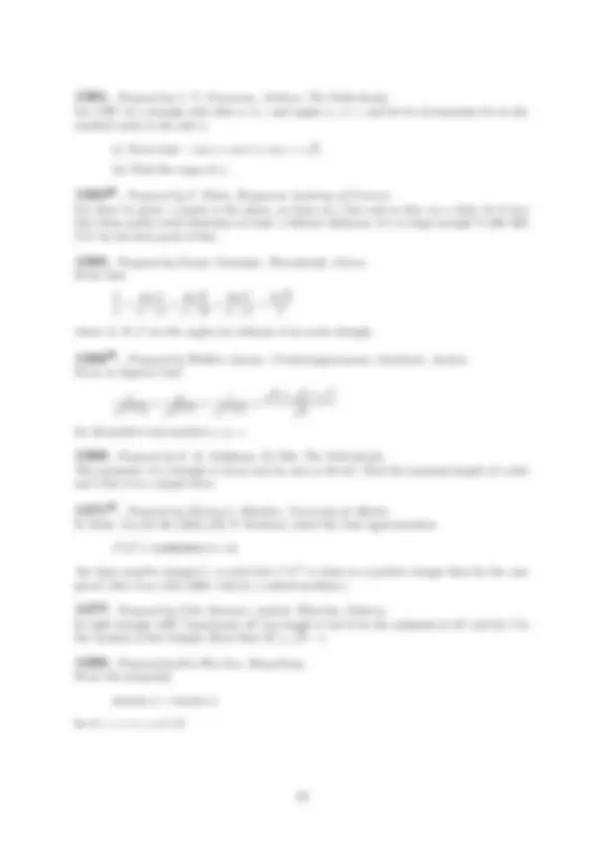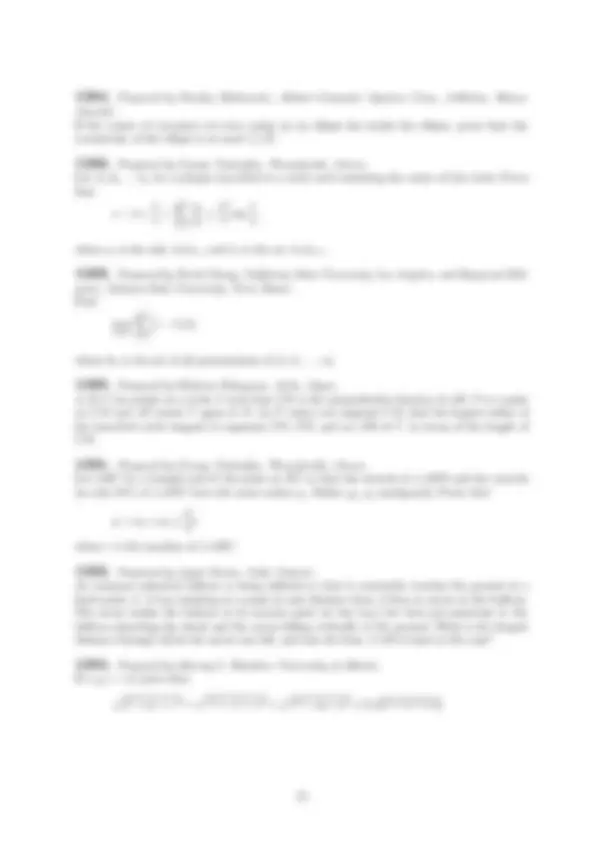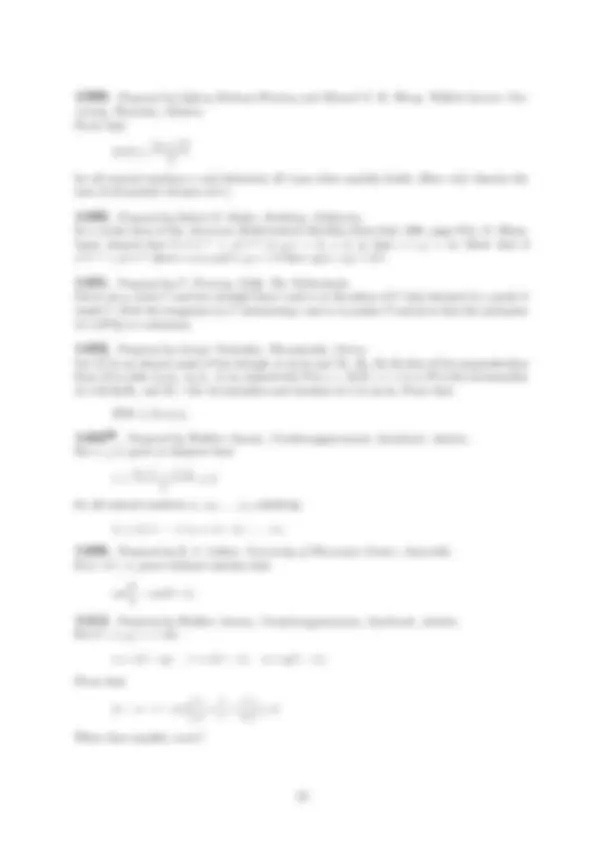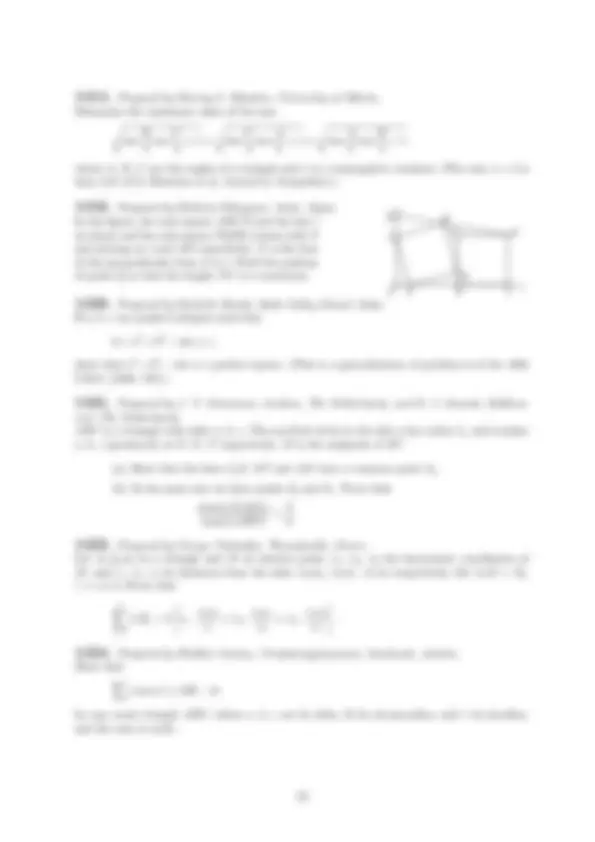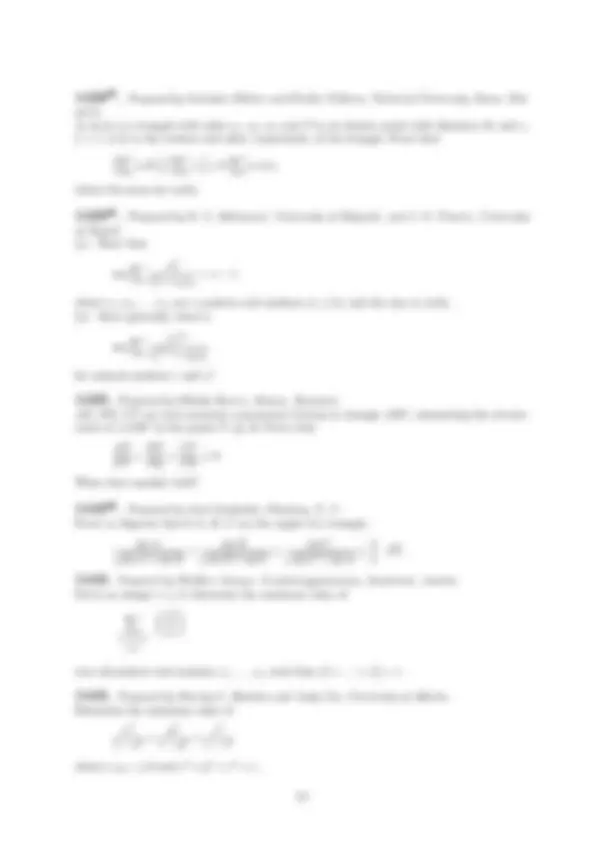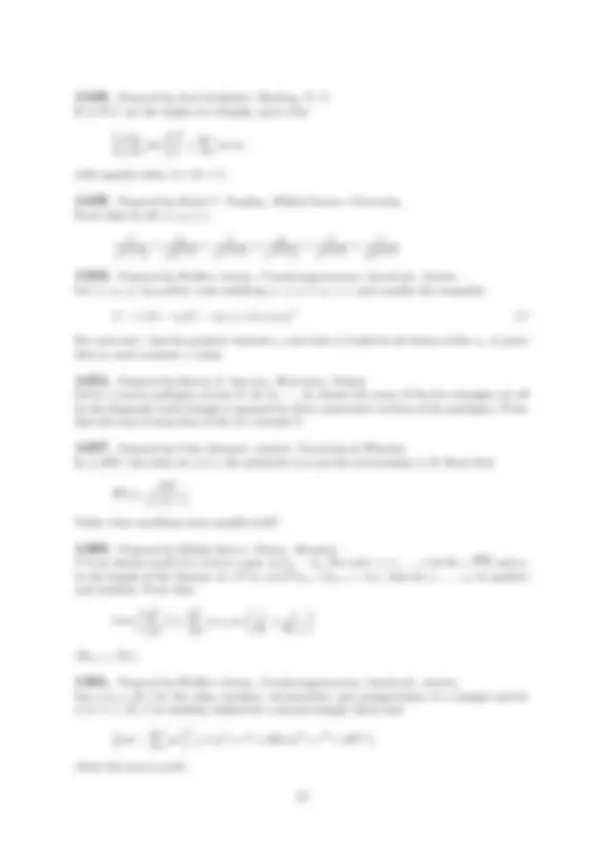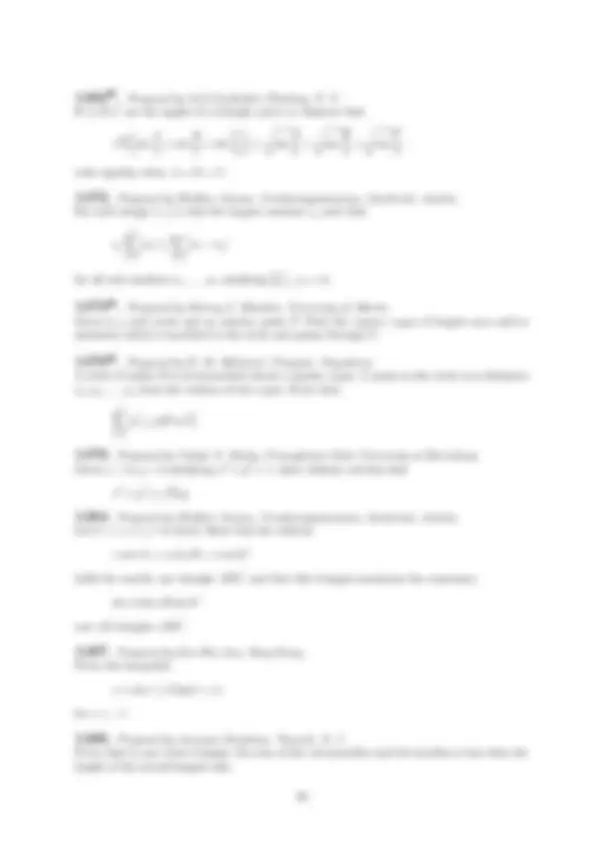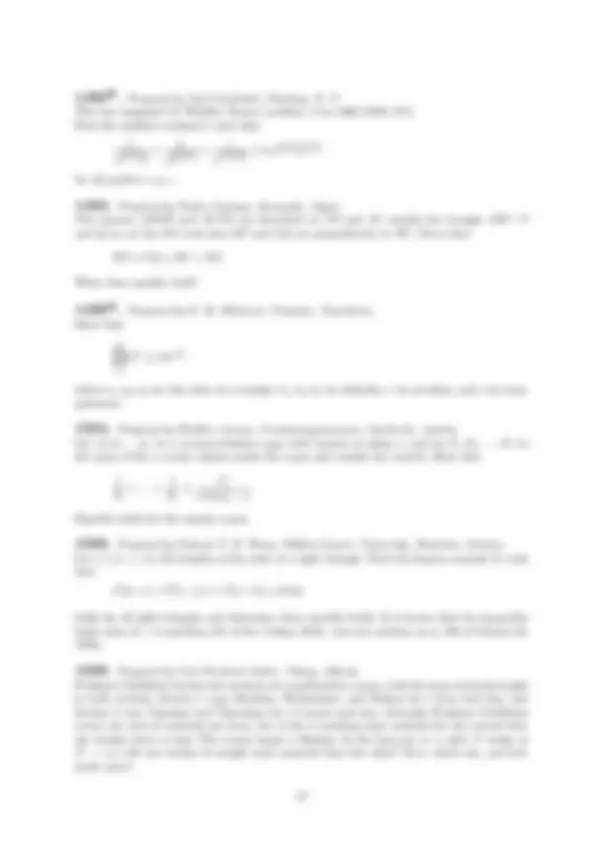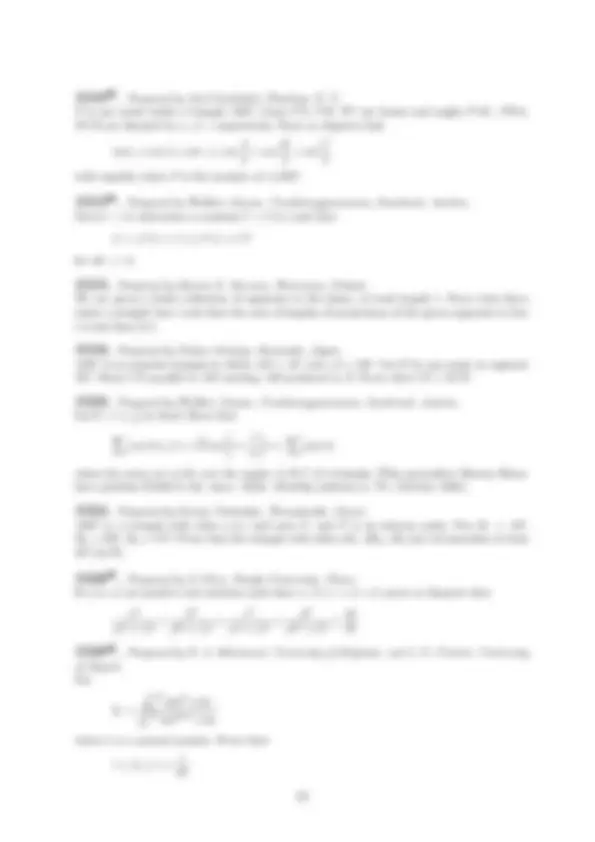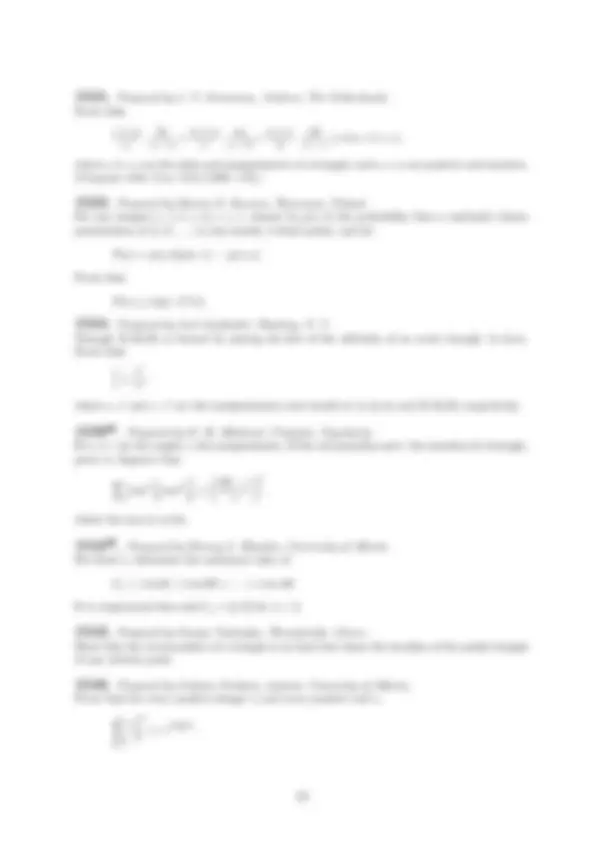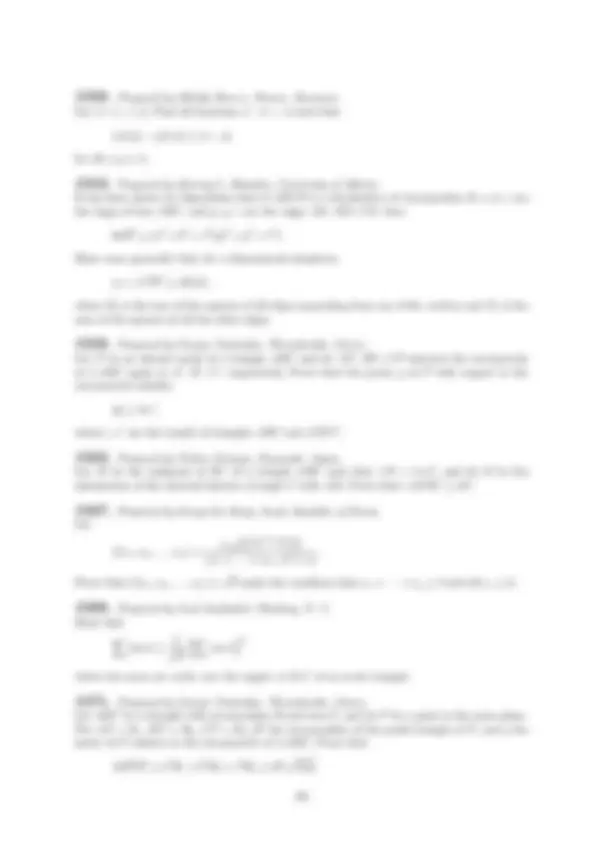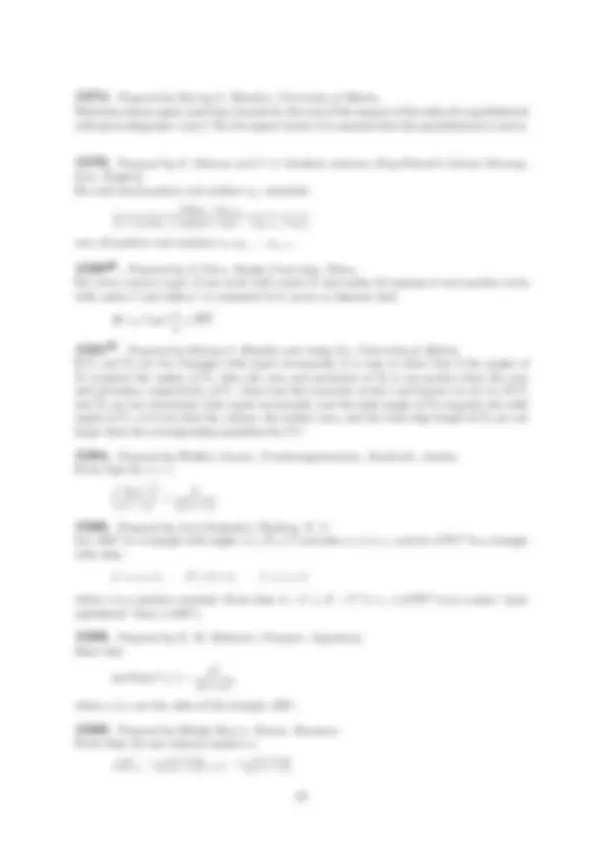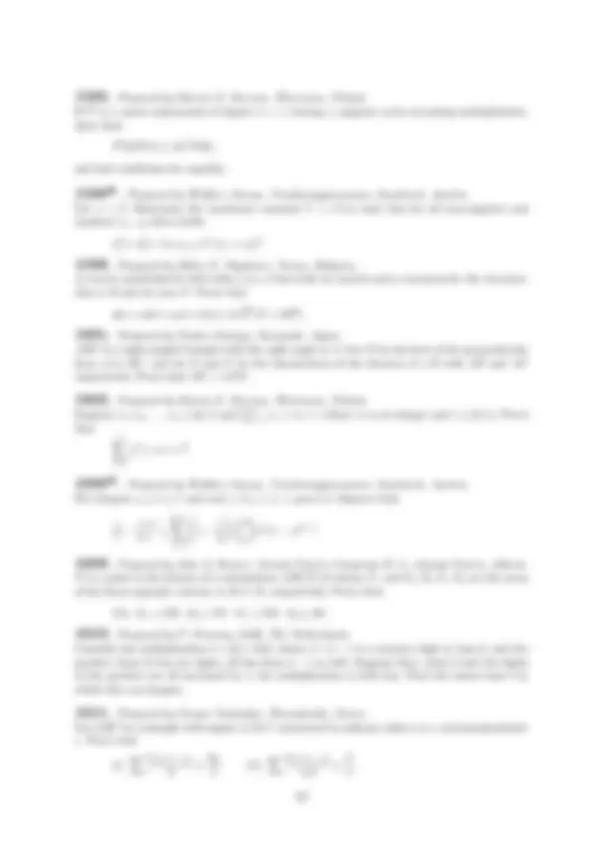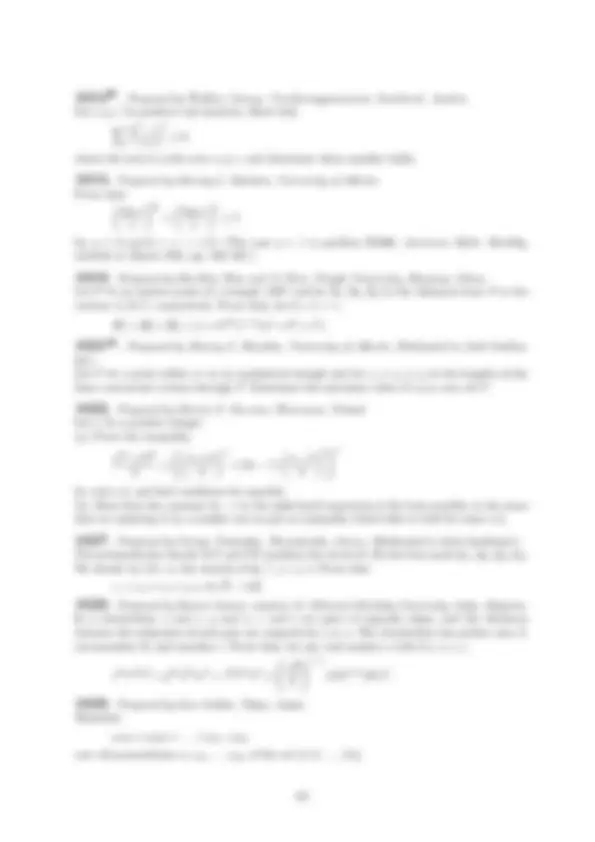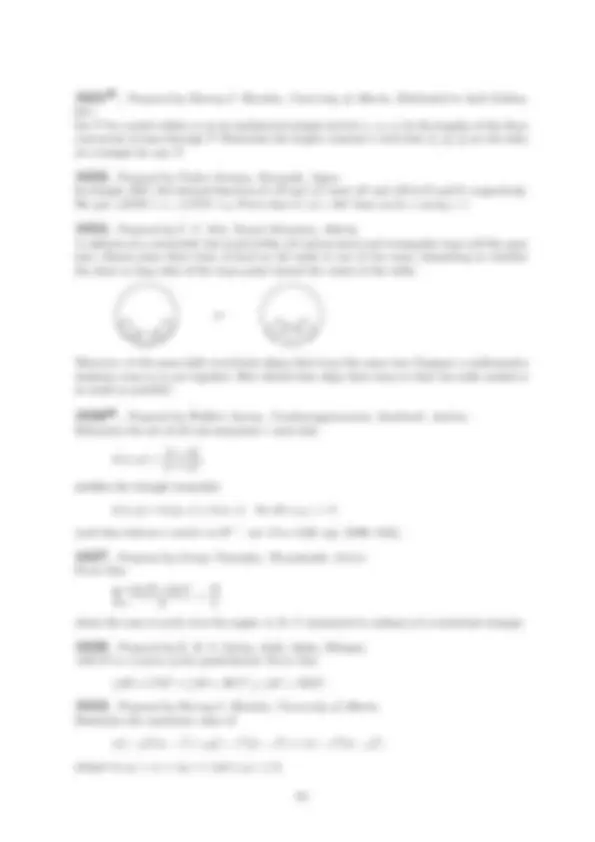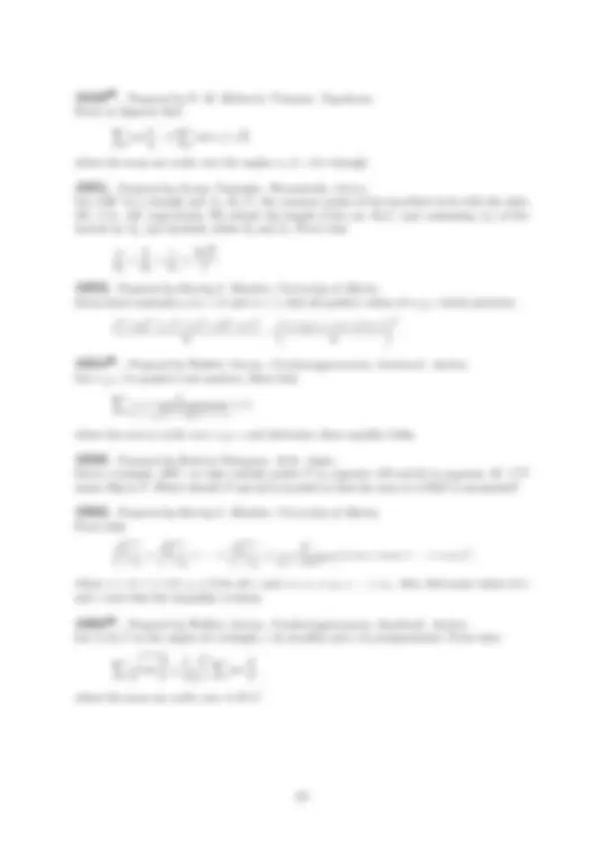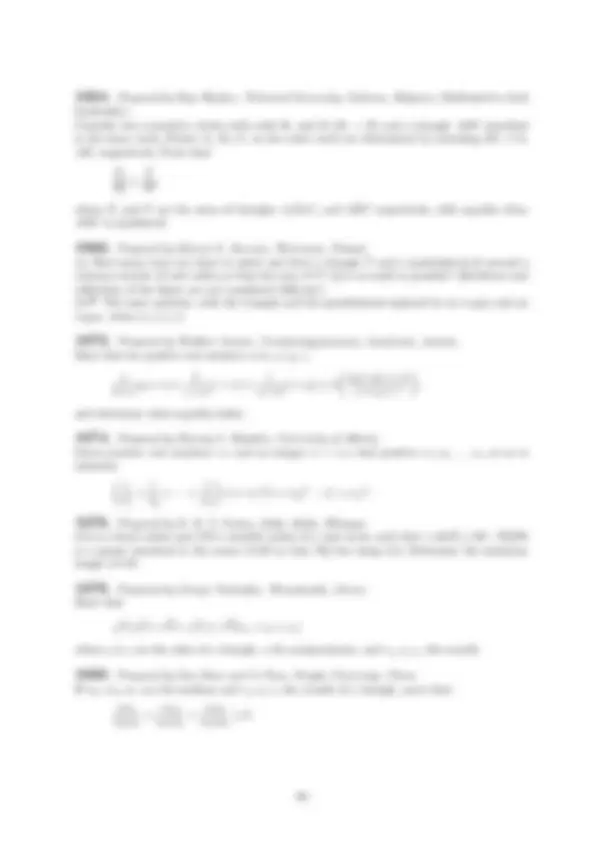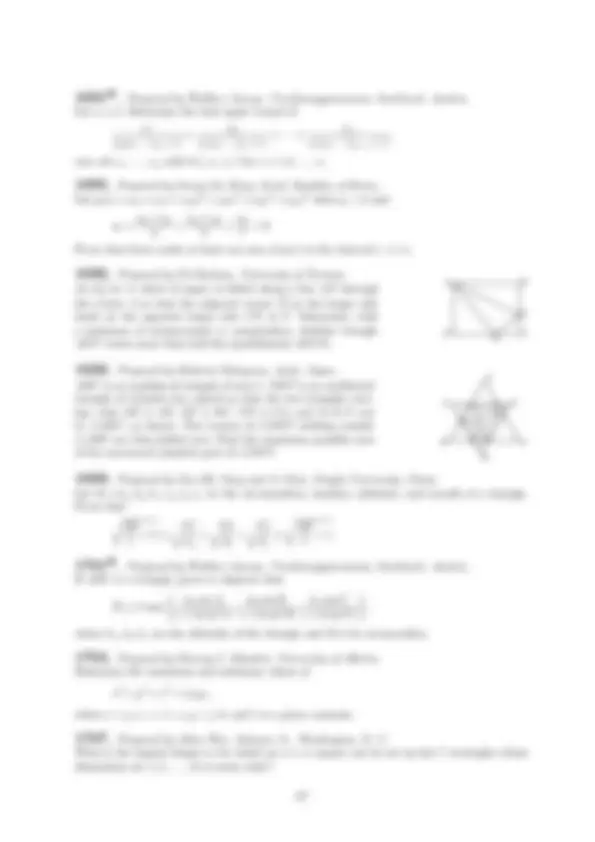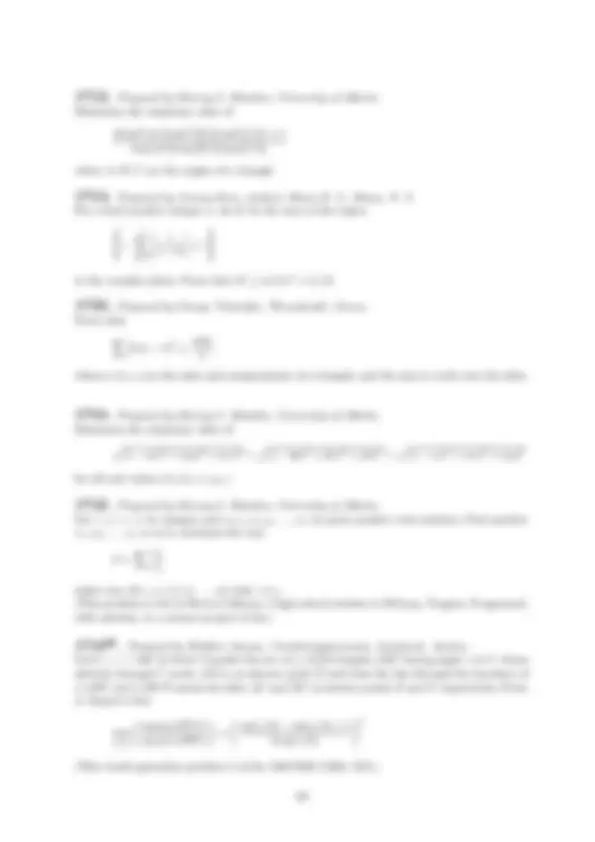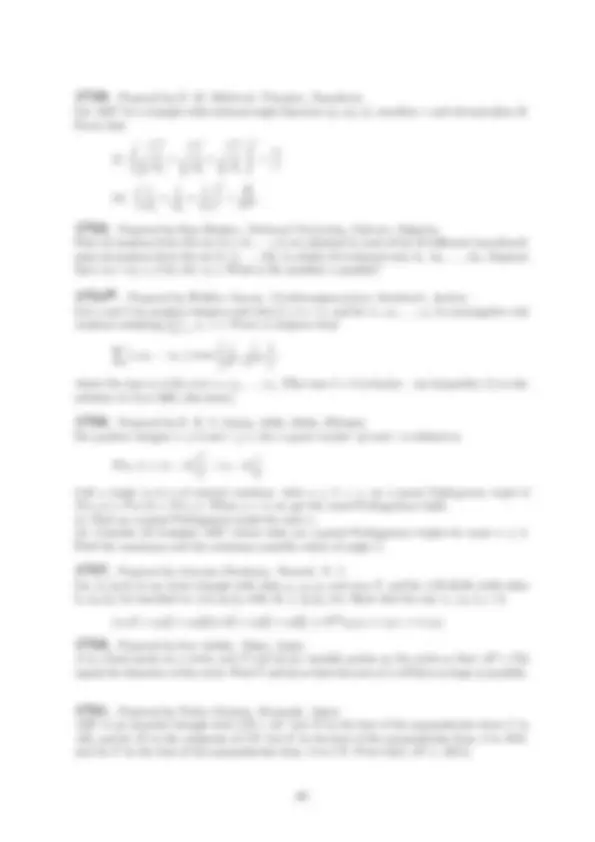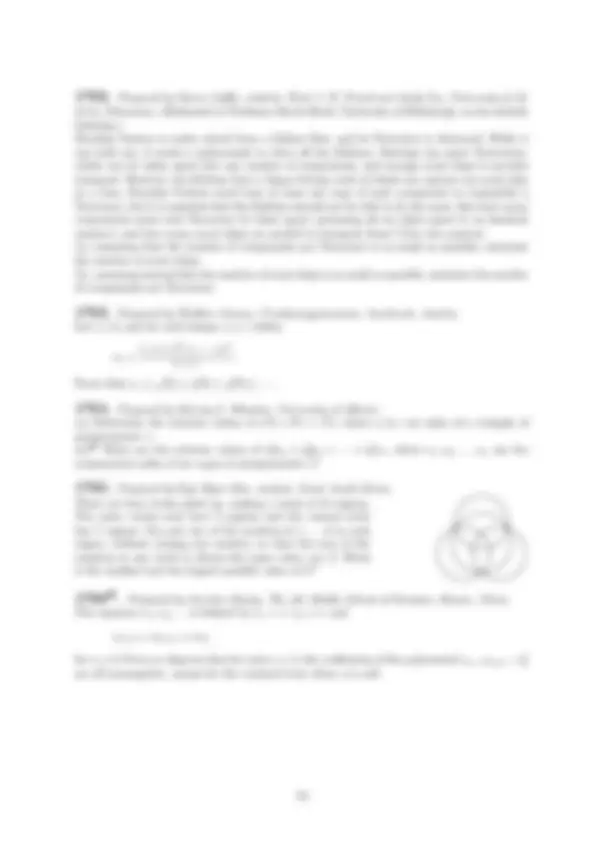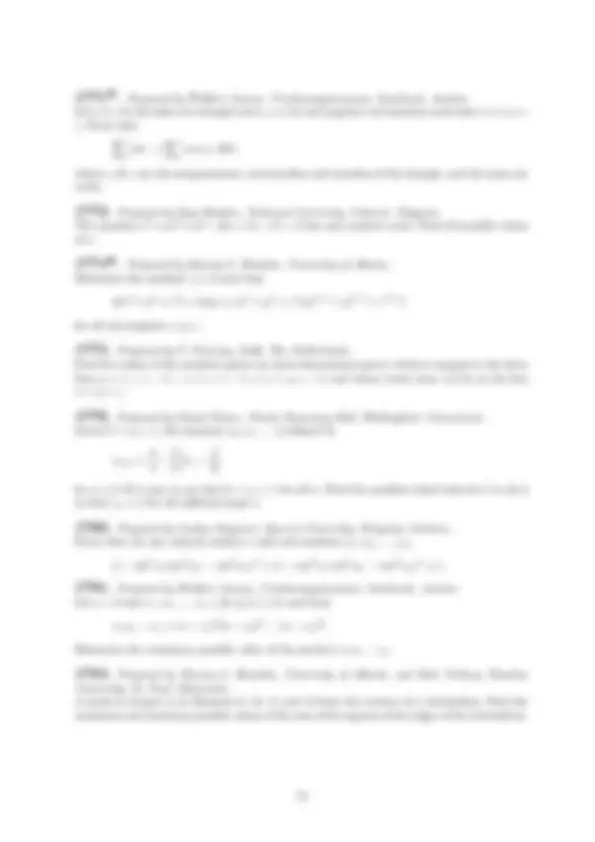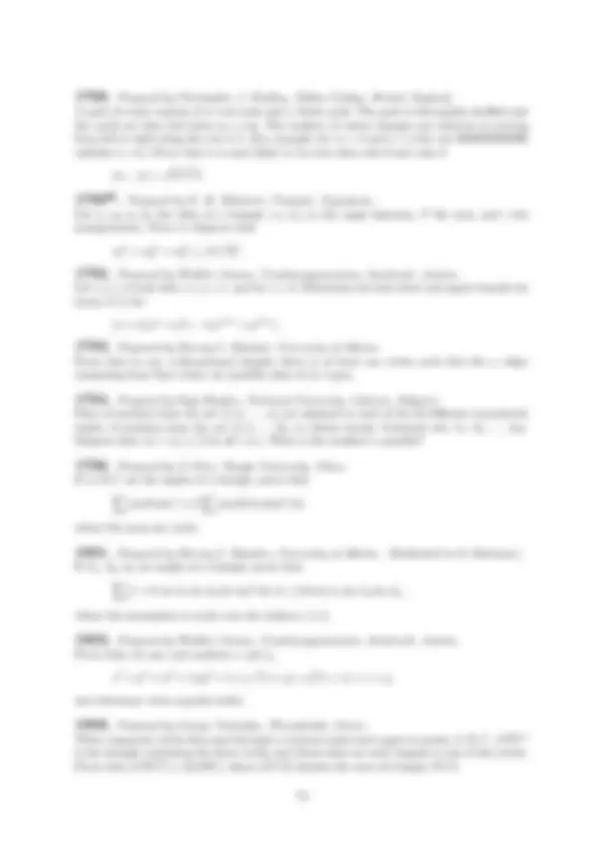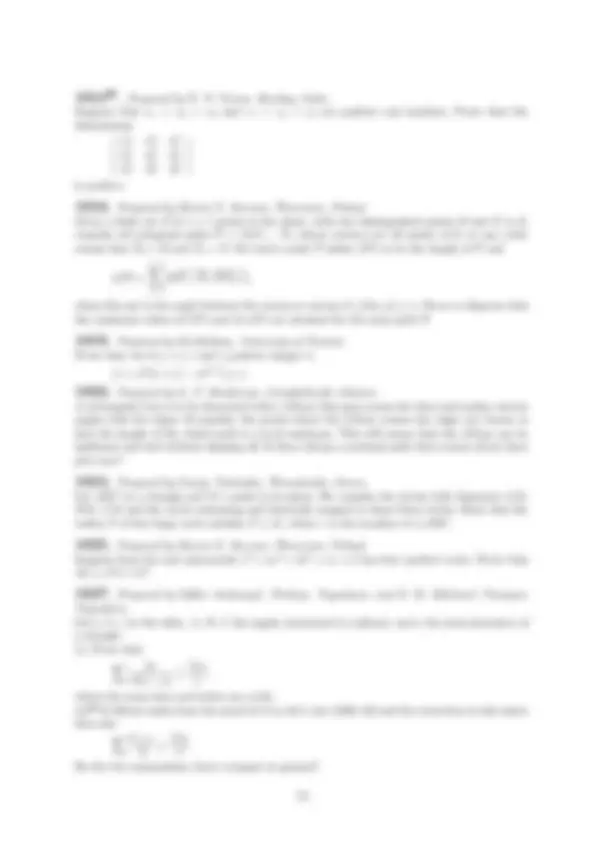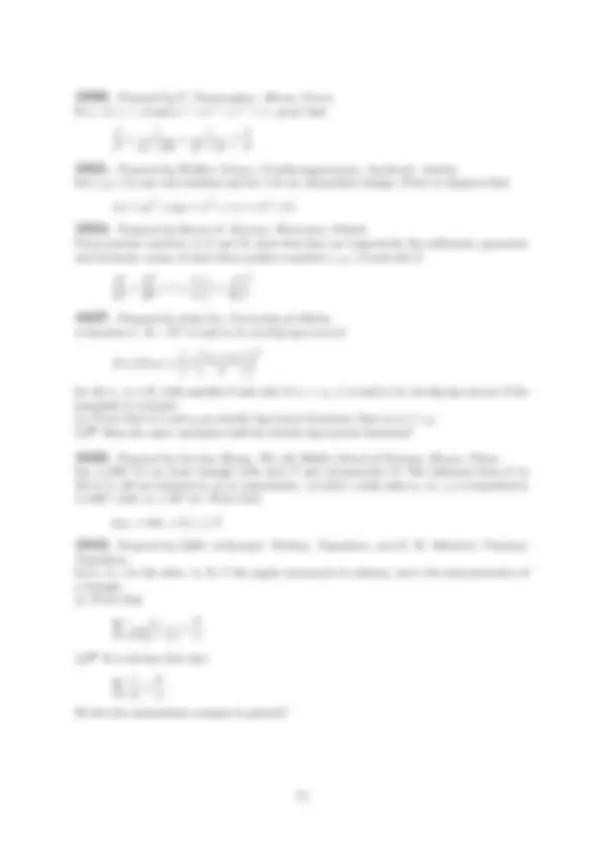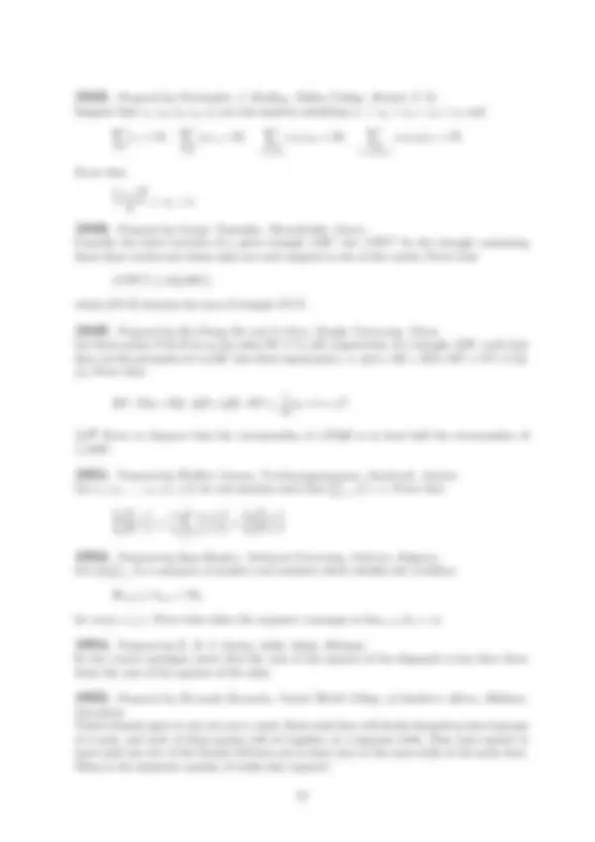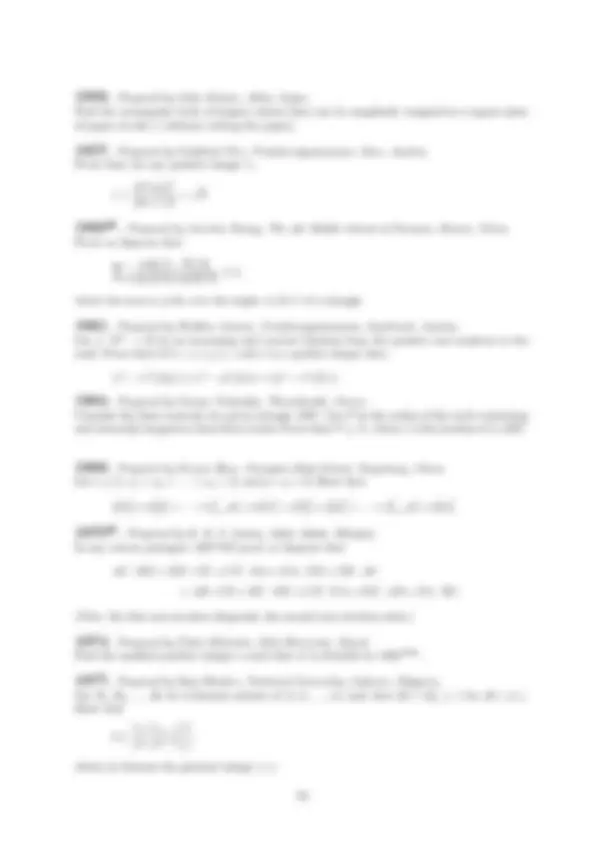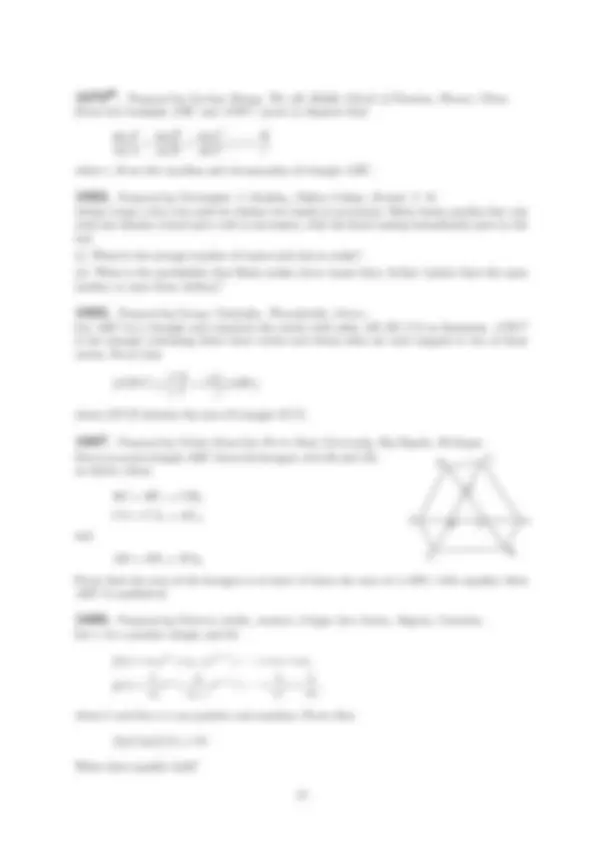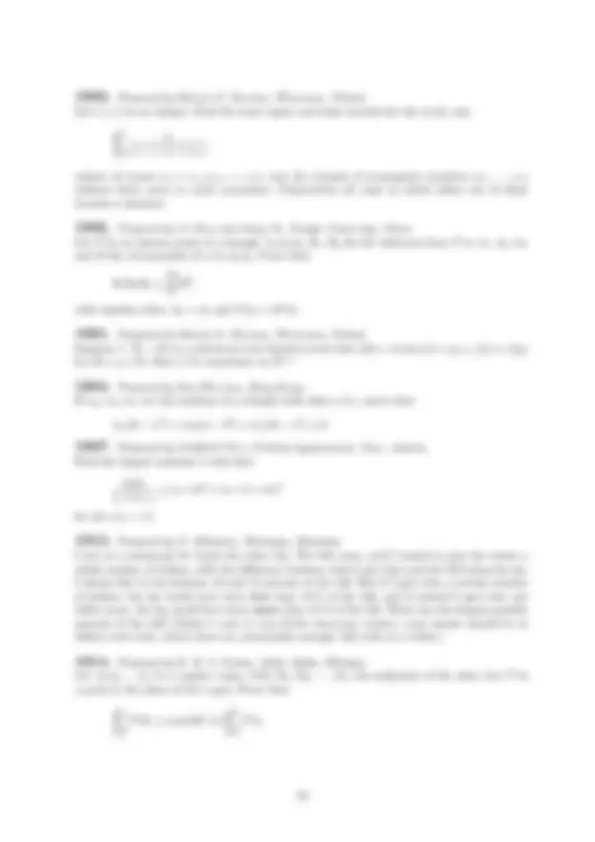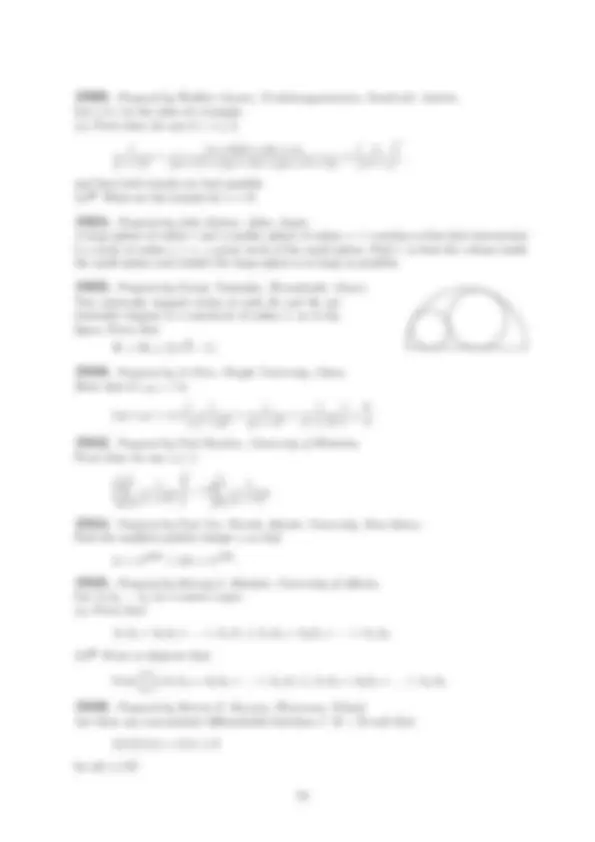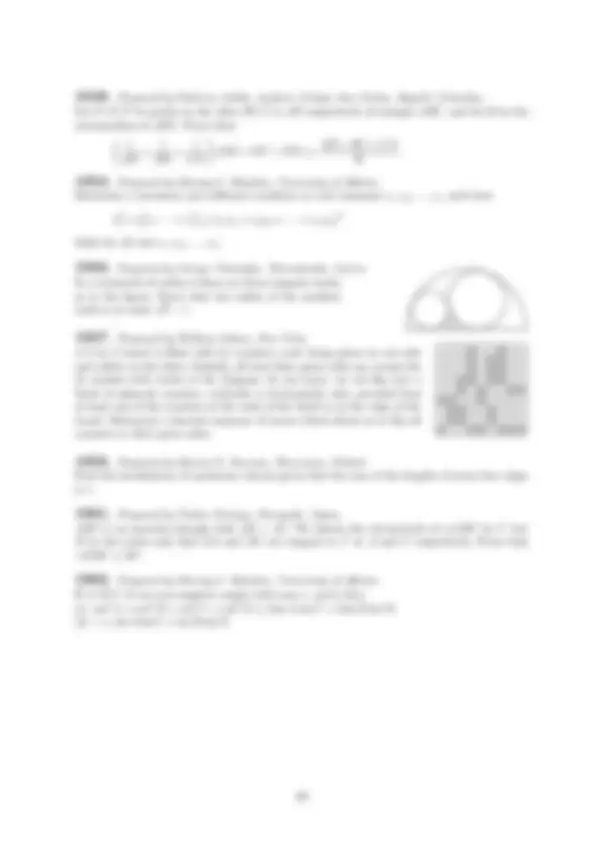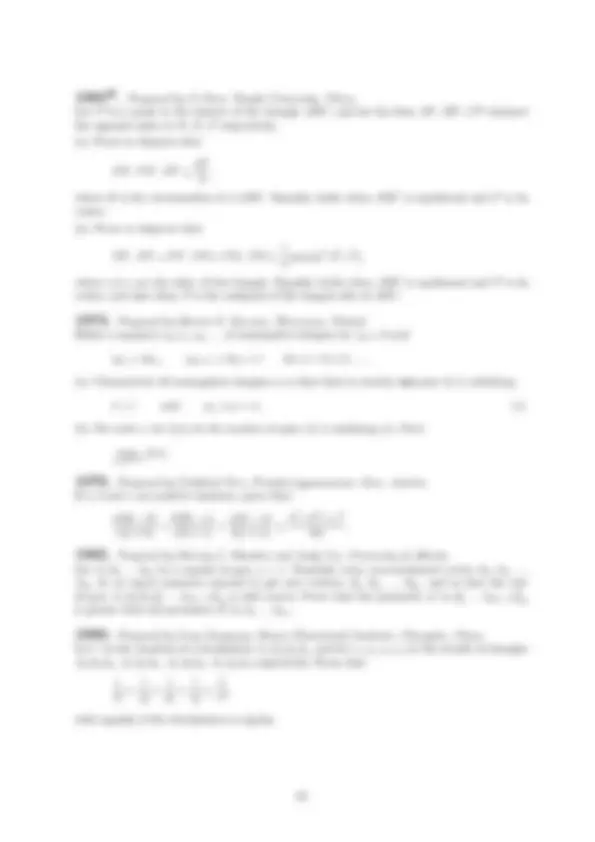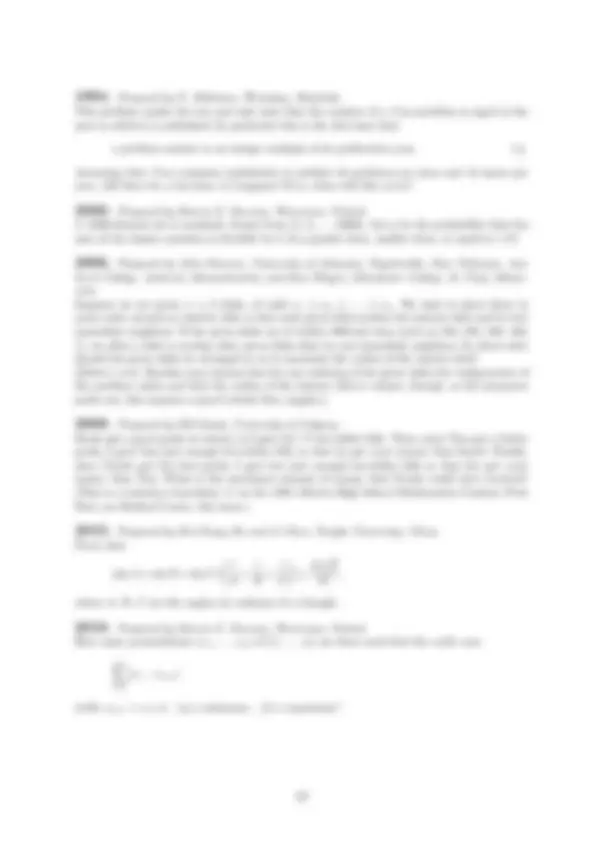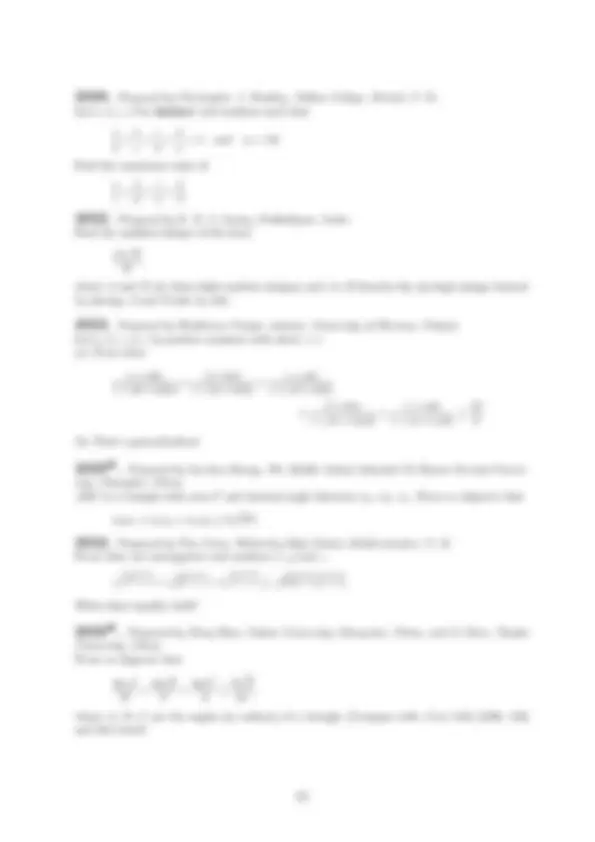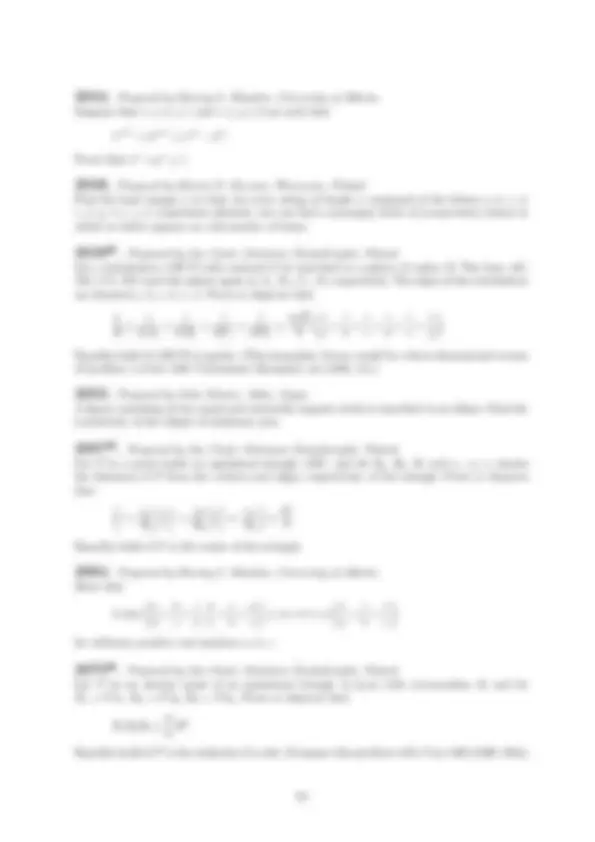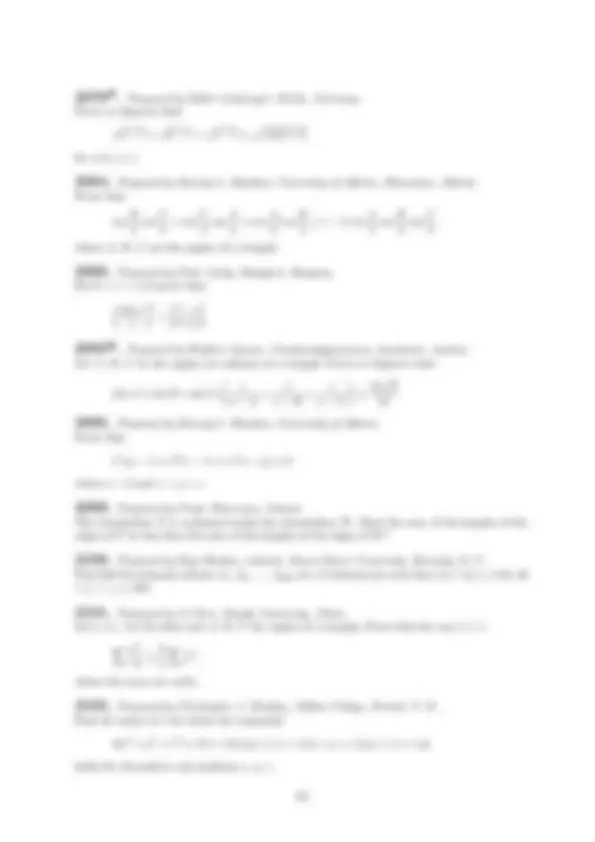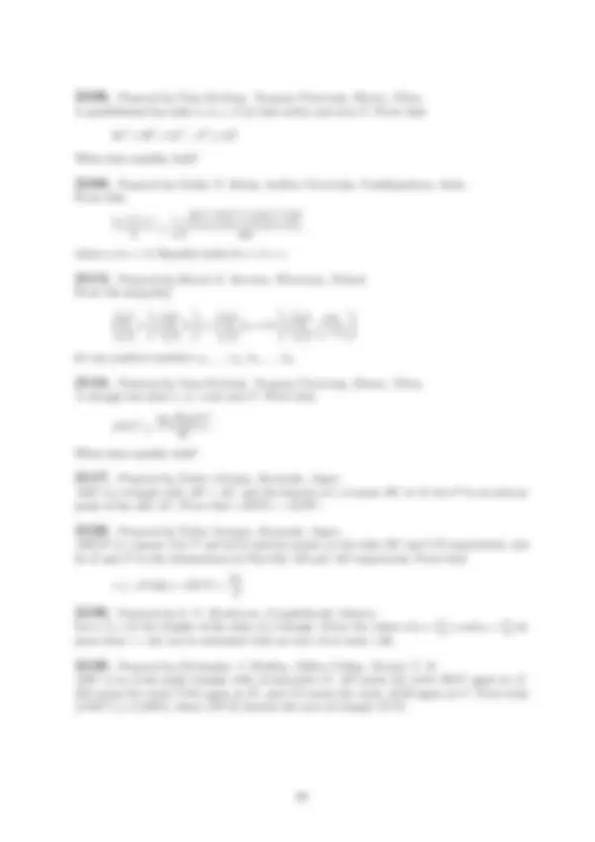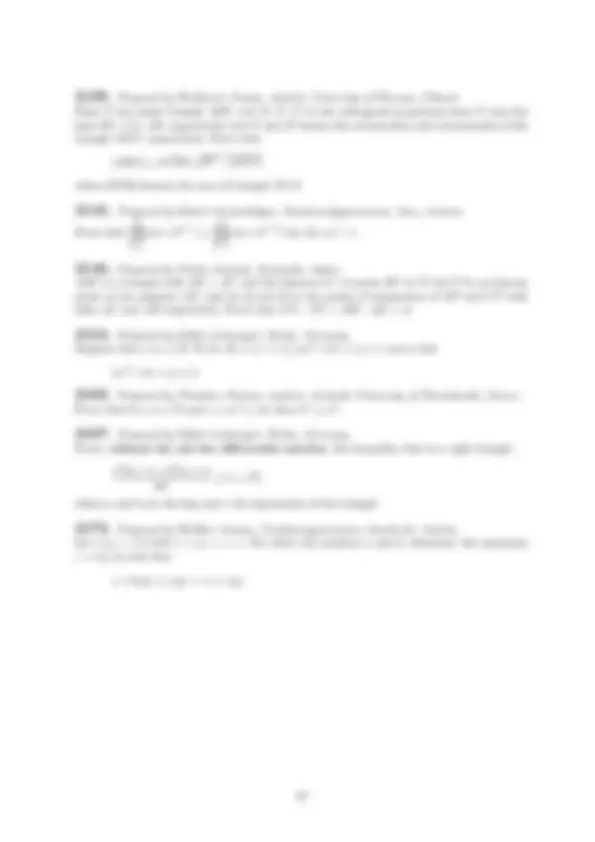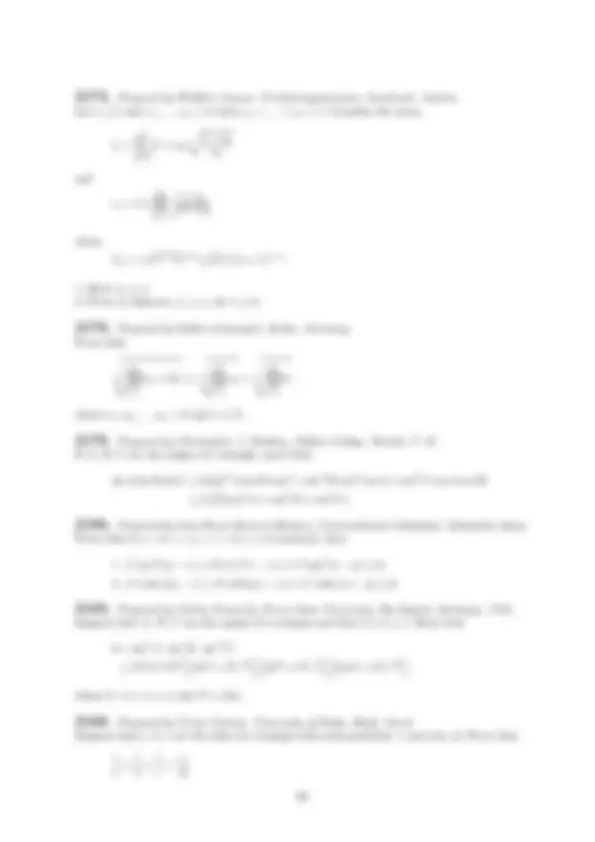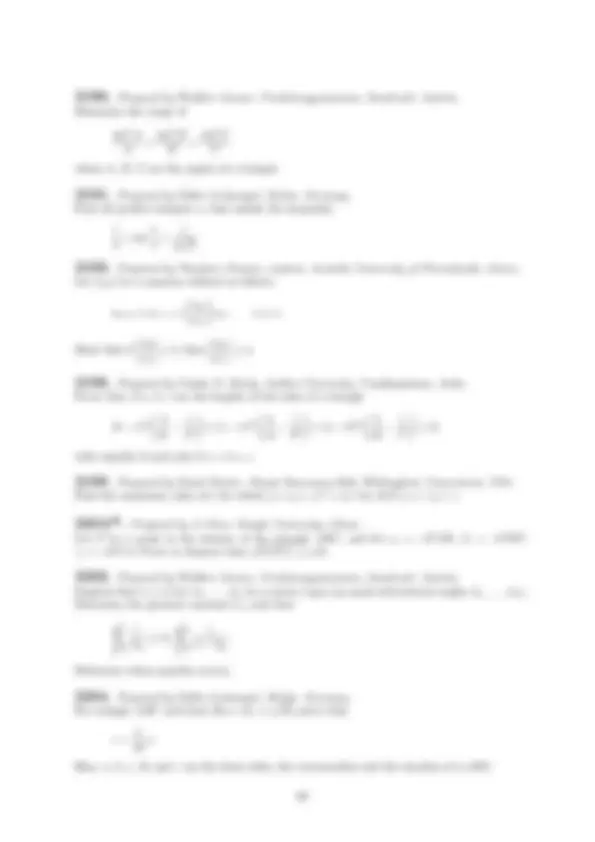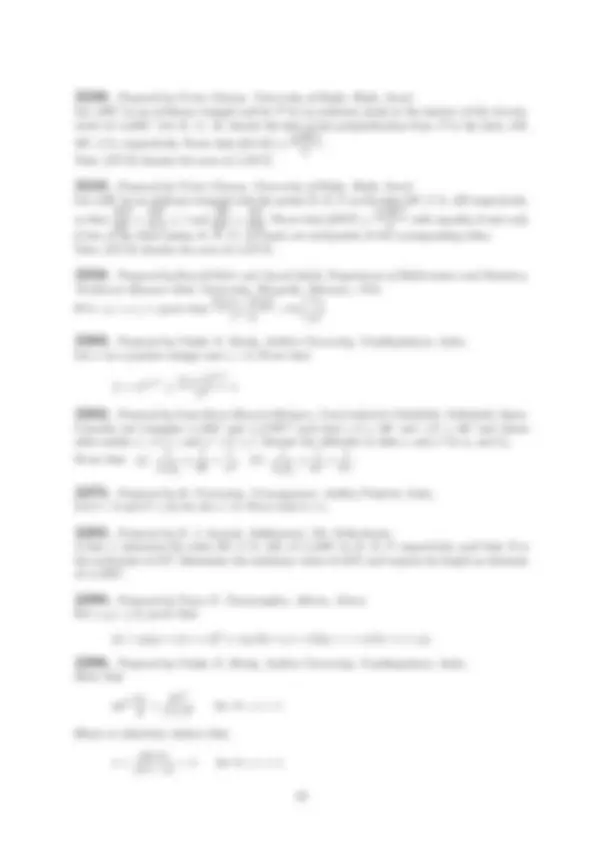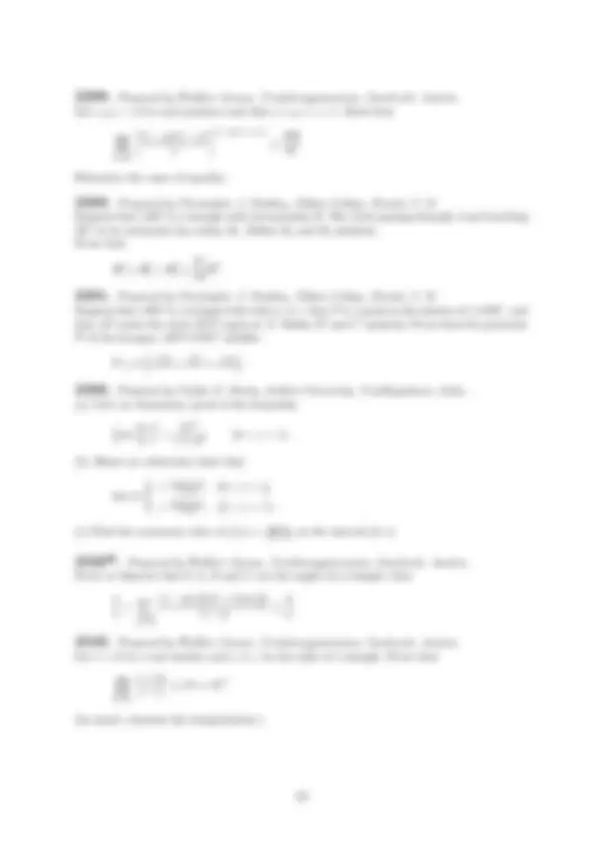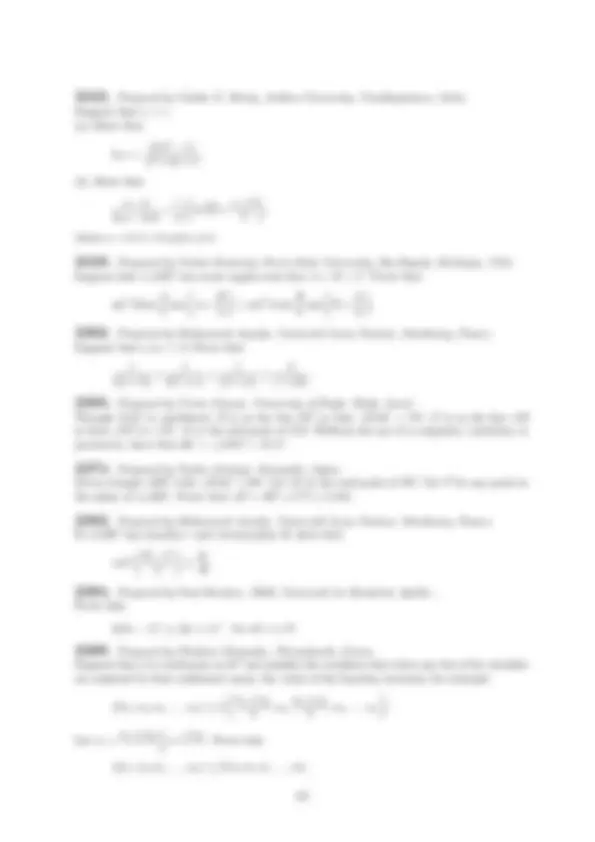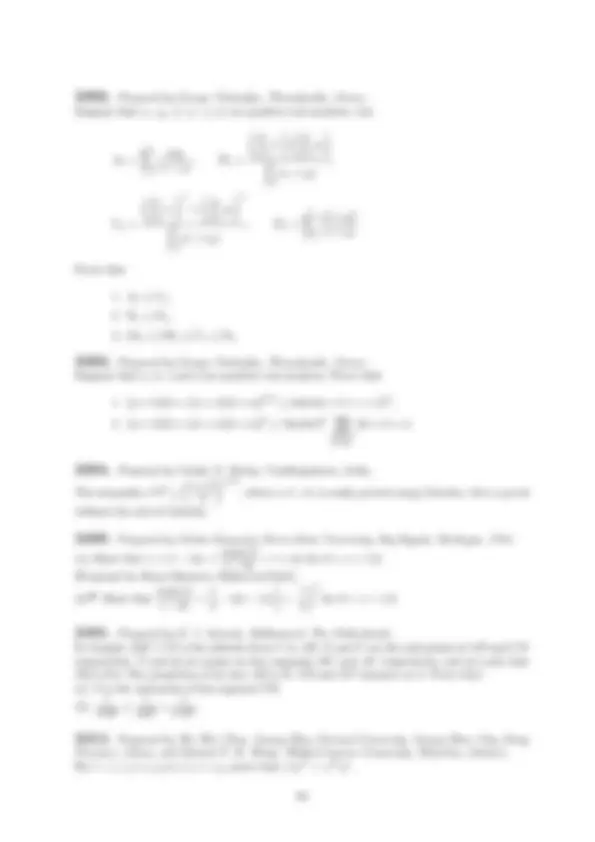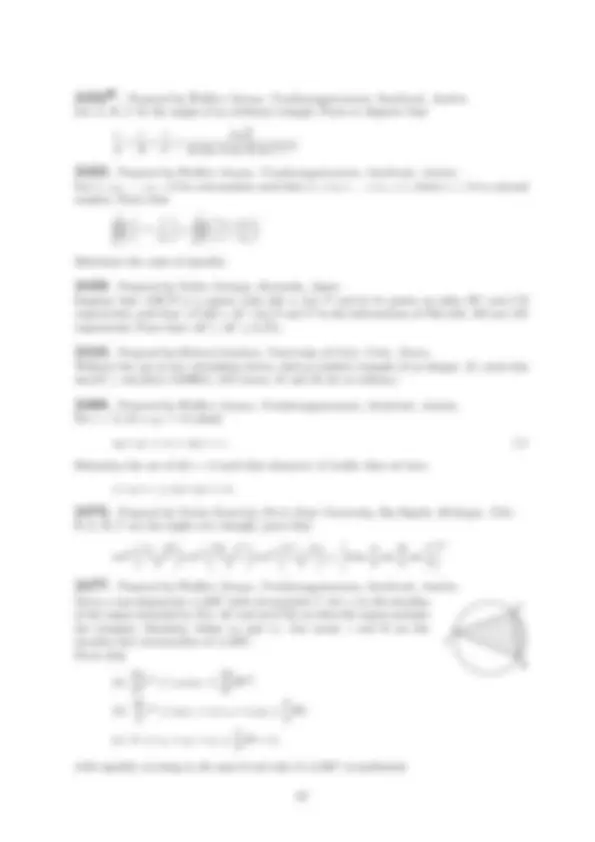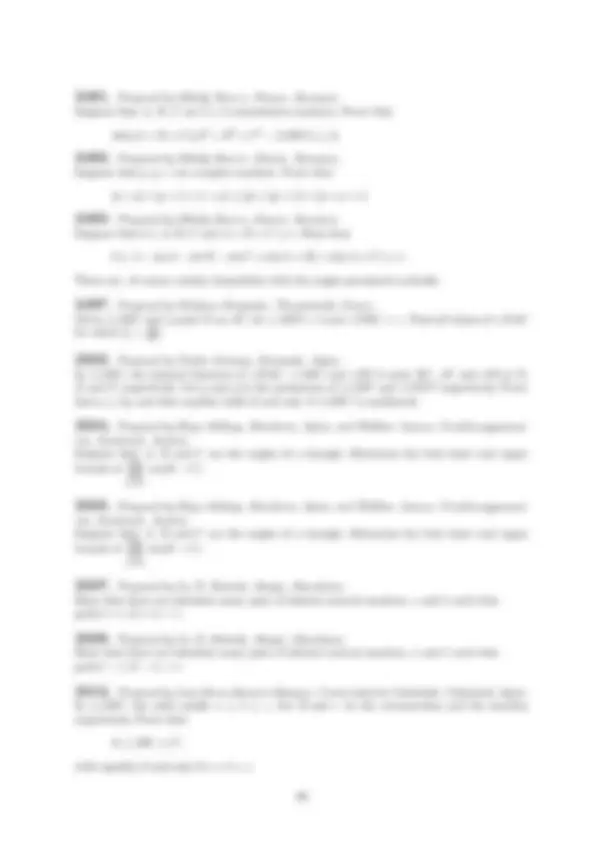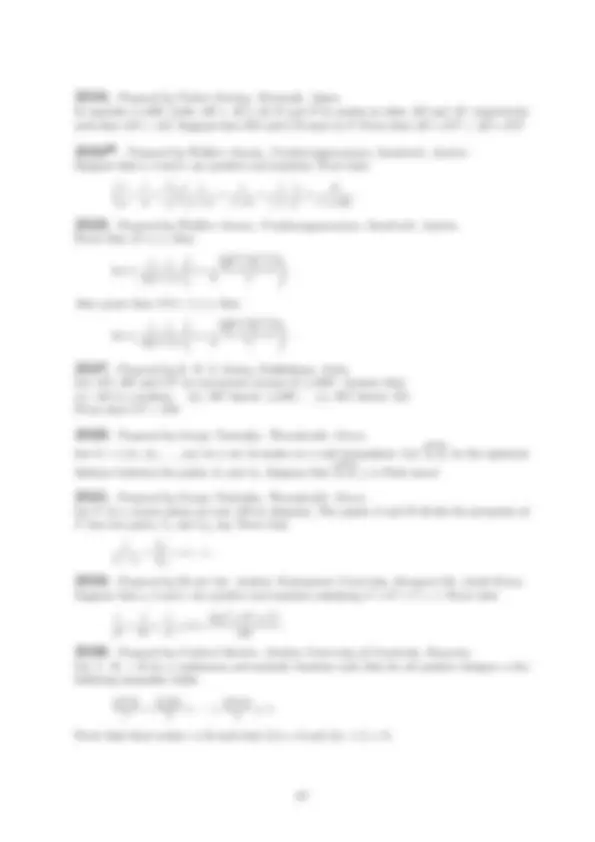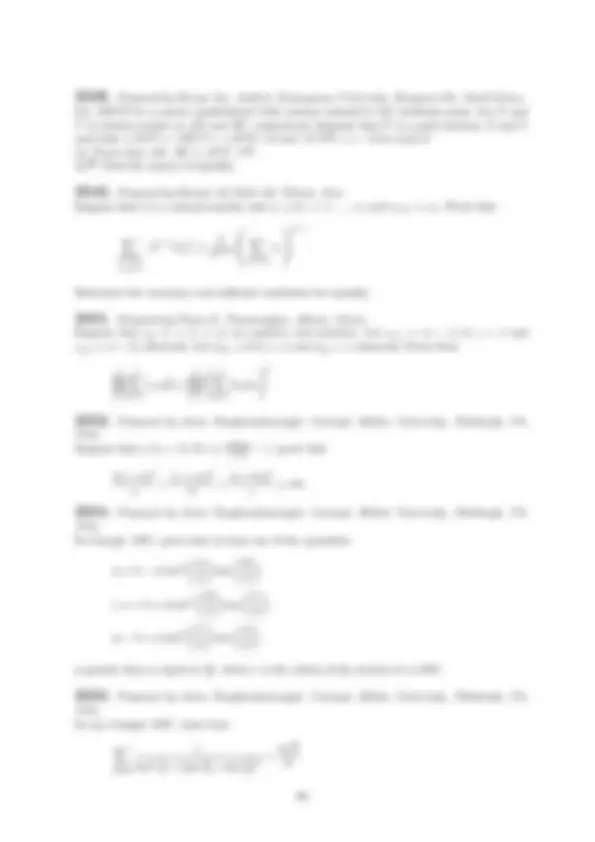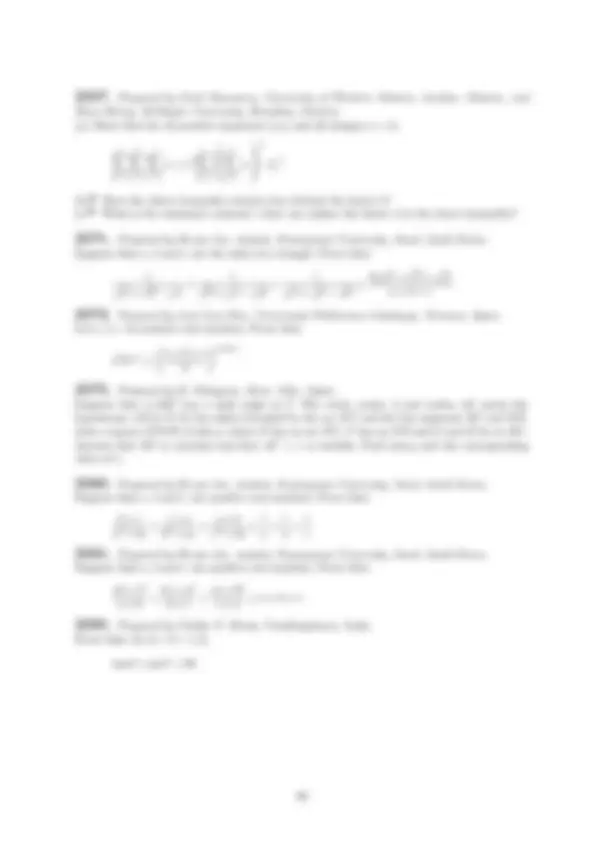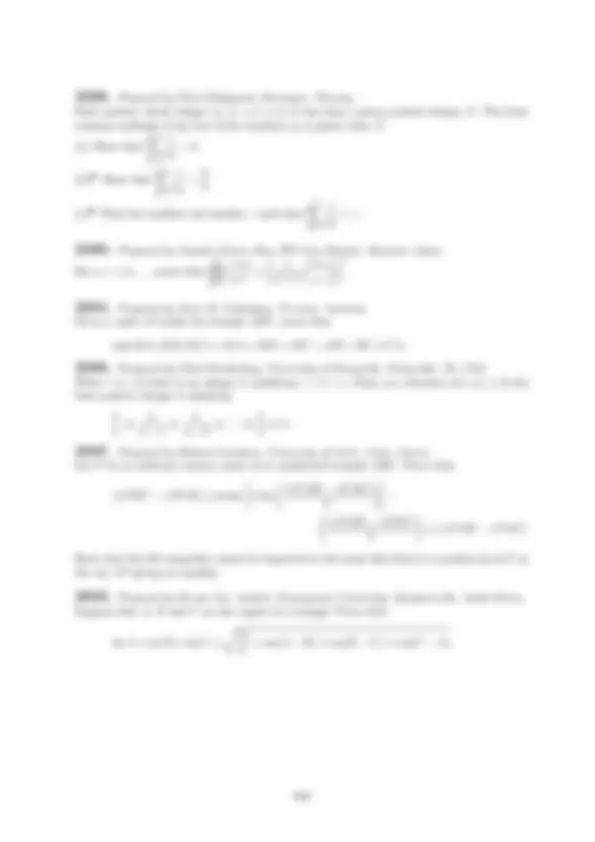Baixe Desigualdades - problemas e outras Notas de estudo em PDF para Biologia Marinha, somente na Docsity!
Inequalities proposed in
“Crux Mathematicorum”
(from vol. 1, no. 1 to vol. 4, no. 2 known as “Eureka”)
Complete and up-to-date: October 7, 2006
The best problem solving journal all over the world; visit http://journals.cms.math.ca/CRUX/
(An asterisk (⋆) after a number indicates that a problem was proposed without a solution.)
2. Proposed by L´eo Sauv´e, Algonquin College.
A rectangular array of m rows and n columns contains mn distinct real numbers. For i = 1 , 2 ,... , m, let si denote the smallest number of the ith^ row; and for j = 1, 2 ,... , n, let lj denote the largest number of the jth^ column. Let A = max{si} and B = min{lj }. Compare A and B.
14. Proposed by Viktors Linis, University of Ottawa.
If a, b, c are lengths of three segments which can form a triangle, show the same for (^) a+^1 c , (^) b+^1 c , 1 a+b.
17. Proposed by Viktors Linis, University of Ottawa.
Prove the inequality
1 2
23. Proposed by L´eo Sauv´e, Coll`ege Algonquin.
D´eterminer s’il existe une suite {un} d’entiers naturels telle que, pour n = 1, 2 , 3 ,.. ., on ait
2 un^ < 2 n + 1 < 2 1+un
25. Proposed by Viktors Linis, University of Ottawa.
Find the smallest positive value of 36k^ − 5 l^ where k and l are positive integers.
29. Proposed by Viktors Linis, University of Ottawa.
Cut a square into a minimal number of triangles with all angles acute.
36. Proposed by L´eo Sauv´e, Coll`ege Algonquin.
Si m et n sont des entiers positifs, montrer que
sin^2 m^ θ cos^2 n^ θ ≤ mmnn (m + n)m+n^
et d`eterminer les valeurs de θ pour lesquelles il y a ´egalit´e.
54. Proposed by L´eo Sauv´e, Coll`ege Algonquin.
Si a, b, c > 0 et a < b + c, montrer que
a 1 + a
b 1 + b
c 1 + c
66. Proposed by John Thomas, University of Ottawa.
What is the largest non-trivial subgroup of the group of permutations on n elements?
74. Proposed by Viktors Linis, University of Ottawa.
Prove that if the sides a, b, c of a triangle satisfy a^2 + b^2 = kc^2 , then k > 12.
- Proposed by R. Duff Butterill, Ottawa Board of Education. M is the midpoint of chord AB of the circle with centre C shown in the figure. Prove that RS > M N.
A B
C M
N
P
R
S
- Proposed by John Thomas, University of Ottawa. Show that, for x > 0, ∣ ∣∣ ∣
∫ (^) x+
x
sin(t^2 ) dt
∣ <^
x^2
- Proposed by Viktors Linis, University of Ottawa. Prove that for any positive integer n
√ nn < 1 +
n
- Proposed by Viktors Linis, University of Ottawa. Prove that, if 0 < a < b, then
ln b^2 a^2
b a
a b
- Proposed by L´eo Sauv´e, Coll`ege Algonquin. Soit f une fonction num´erique continue et non n´egative pour tout x ≥ 0. On suppose qu’il existe un nombre r´eel a > 0 tel que, pout tout x > 0,
f (x) ≤ a
∫ (^) x
0
f (t) dt.
Montrer que la fonction f est nulle.
- Proposed by Viktors Linis, University of Ottawa. Prove that, for any quadrilateral with sides a, b, c, d,
a^2 + b^2 + c^2 >
d^2.
- Proposed by Viktors Linis, University of Ottawa. Prove that, for all integers n ≥ 2,
∑^ n
k=
k^2
3 n 2 n + 1
- Proposed by H. G. Dworschak, Algonquin College. (a) Let AB and P R be two chords of a circle intersecting at Q. If A, B, and P are kept fixed, characterize geometrically the position of R for which the length of QR is maximal. (See figure). (b) Give a Euclidean construction for the point R which maximizes the length of QR, or show that no such construction is possible.
A Q B
P
R
- Proposed by Viktors Linis, University of Ottawa. Prove the following inequality of Huygens:
2 sin α + tan α ≥ 3 α, 0 ≤ α < π 2
- Proposed by Dan Eustice, The Ohio State University. Prove that, for each choice of n points in the plane (at least two distinct), there exists a point on the unit circle such that the product of the distances from the point to the chosen points is greater than one.
- Proposed by L´eo Sauv´e, Algonquin College. The first half of the Snellius-Huygens double inequality
1 3 (2 sin α + tan α) > α > 3 sin α 2 + cos α , 0 < α < π 2
was proved in Problem 115. Prove the second half in a way that could have been understood before the invention of calculus.
- Proposed by Dan Eustice, The Ohio State University. For each choice of n points on the unit circle (n ≥ 2), there exists a point on the unit circle such that the product of the distances to the chosen points is greater than or equal to 2. Moreover, the product is 2 if and only if the n points are the vertices of a regular polygon.
- Proposed by Steven R. Conrad, Benjamin N. Cardozo H. S., Bayside, N. Y. The equation 5x + 7y = c has exactly three solutions (x, y) in positive integers. Find the largest possible value of c.
- Proposed by Ross Honsberger, University of Waterloo. Prove that (^2) rr+2+5 is always a better approximation of
5 than r.
- Proposed by R. Robinson Rowe, Sacramento, California. Find the least integer N which satisfies
N = aa+2b^ = bb+2a, a 6 = b.
- Proposed by Steven R. Conrad, Benjamin N. Cardozo H. S., Bayside, N. Y. Without using any table which lists Pythagorean triples, find the smallest integer which can represent the area of two noncongruent primitive Pythagorean triangles.
- Proposed by Kenneth M. Wilke, Topeka, Kansas. On an examination, one question asked for the largest angle of the triangle with sides 21, 41, and 50. A student obtained the correct answer as follows: Let C denote the desired angle; then sin C = 5041 = 1 + 419. But sin 90◦^ = 1 and 419 = sin 12◦^40 ′^49 ′′. Thus
C = 90◦^ + 12◦^40 ′^49 ′′^ = 102◦^40 ′^49 ′′,
which is correct. Find the triangle of least area having integral sides and possessing this property.
- Proposed by R. Robinson Rowe, Sacramento, California. Find the least integer N which satisfies
N = ama+nb^ = bmb+na
with m and n positive and 1 < a < b. (This generalizes Problem 219.)
247 ⋆. Proposed by Kenneth S. Williams, Carleton University, Ottawa, Ontario. On page 215 of Analytic Inequalities by D. S. Mitrinovi´c, the following inequality is given: if 0 < b ≤ a then
1 8
(a − b)^2 a
a + b 2
ab ≤
(a − b)^2 b
Can this be generalized to the following form: if 0 < a 1 ≤ a 2 ≤ · · · ≤ an then
k
1 ≤i<j≤n
(ai − aj )^2
an
a 1 + · · · + an n
− n
a 1 · · · an ≤ k
1 ≤i<j≤n
(ai − aj )^2
a 1
where k is a constant?
- Proposed by L. F. Meyers, The Ohio State University. A jukebox has N buttons. (a) If the set of N buttons is subdivided into disjoint subsets, and a customer is required to press exactly one button from each subset in order to make a selection, what is the distribution of buttons which gives the maximum possible number of different selections? (b) What choice of n will allow the greatest number of selections if a customer, in making a selection, may press any n distinct buttons out of the N? How many selections are possible then? (Many jukeboxes have 30 buttons, subdivided into 20 and 10. The answer to part (a) would then be 200 selections.)
- Proposed by Erwin Just and Sidney Penner, Bronx Community College. On a 6×6 board we place 3×1 trominoes (each tromino covering exactly three unit squares of the board) until no more trominoes can be accommodated. What is the maximum number of squares that can be left vecant?
- Proposed by L. F. Meyers, The Ohio State University. Derive the laws of reflection and refraction from the principle of least time without use of calculus or its equivalent. Specifically, let L be a straight line, and let A and B be points not on L. Let the speed of light on the side of L on which A lies be c 1 , and let the speed of light on the other side of L be c 2. Characterize the points C on L for which the time taken for the route ACB is smallest, if (a) A and B are on the same side of L (reflection); (b) A and B are on opposite sides of L (refraction).
- Proposed by Basil C. Rennie, James Cook University of North Queensland, Australia. If 0 < b ≤ a, prove that
a + b − 2
ab ≥
(a − b)^2 a + b
- Proposed by Viktors Linis, University of Ottawa. Huygens’ inequality 2 sin α + tan α ≥ 3 α was proved in Problem 115. Prove the following hyper- bolic analogue:
2 sinh x + tanh x ≥ 3 x, x ≥ 0.
- Proposed by Viktors Linis, University of Ottawa. Prove the following inequality:
ln x x − 1
x x + 3
x , x > 0 , x 6 = 1.
- Proposed by Kenneth S. Williams, Carleton University, Ottawa, Ontario. In Crux 247 [1977: 131; 1978: 23, 37] the following inequality is proved:
2 n^2
1 ≤i<j≤n
(ai − aj )^2
an
a 1 + · · · + an n − n
a 1 · · · an ≤
2 n^2
1 ≤i<j≤n
(ai − aj )^2
a 1
Prove that the constant (^2) n^12 is best possible.
367 ⋆. Proposed by Viktors Linis, University of Ottawa. (a) A closed polygonal curve lies on the surface of a cube with edge of length 1. If the curve intersects every face of the cube, show that the length of the curve is at least 3
(b) Formulate and prove similar theorems about (i) a rectangular parallelepiped, (ii) a regular tetrahedron.
- Proposed by Murray S. Klamkin, University of Alberta. A convex n-gon P of cardboard is such that if lines are drawn parallel to all the sides at distances x from them so as to form within P another polygon P ′, then P ′^ is similar to P. Now let the corresponding consecutive vertices of P and P ′^ be A 1 , A 2 ,... , An and A′ 1 , A′ 2 ,... , A′ n, respectively. From A′ 2 , perpendiculars A′ 2 B 1 , A′ 2 B 2 are drawn to A 1 A 2 , A 2 A 3 , respectively, and the quadrilateral A′ 2 B 1 A 2 B 2 is cut away. Then quadrilaterals formed in a similar way are cut away from all the other corners. The remainder is folded along A′ 1 A′ 2 , A′ 2 A′ 3 ,... , A′ nA′ 1 so as to form an open polygonal box of base A′ 1 A′ 2... A′ n and of height x. Determine the maximum volume of the box and the corresponding value of x.
- Proposed by Harry D. Ruderman, Hunter College Campus School, New York. A wine glass has the shape of an isosceles trapezoid rotated about its axis of symmetry. If R, r, and h are the measures of the larger radius, smaller radius, and altitude of the trapezoid, find r : R : h for the most economical dimensions.
395 ⋆. Proposed by Kenneth S. Williams, Carleton University, Ottawa, Ontario. In Crux 247 [1977: 131; 1978: 23, 37] the following inequality is proved:
2 n^2
1 ≤i<j≤n
(ai − aj )^2
an
≤ A − G ≤
2 n^2
1 ≤i<j≤n
(ai − aj )^2
a 1
where A (resp. G) is the arithmetic (resp. geometric) mean of a 1 ,... , an. This is a refinement of the familiar inequality A ≥ G. If H denotes the harmonic mean of a 1 ,... , an, that is,
1 H
n
a 1
an
find the corresponding refinement of the familiar inequality G ≥ H.
- Proposed by Jack Garfunkel, Forest Hills H. S., Flushing, N. Y. Given is △ABC with incenter I. Lines AI, BI, CI are drawn to meet the incircle (I) for the first time in D, E, F , respectively. Prove that
(AD + BE + CF )
is not less than the perimeter of the triangle of maximum perimeter that can be inscribed in circle (I).
- Proposed by the late R. Robinson Rowe, Sacramento, California. An army with an initial strength of A men is exactly decimeted each day of a 5-day battle and reinforced each night wirh R men from the reserve pool of P men, winding up on the morning of the 6th day with 60 % of its initial strength. At least how large must the initial strength have been if (a) R was a constant number each day; (b) R was exactly half the men available in the dwindling pool?
- Proposed by Andy Liu, University of Alberta. Let A be a set of n distinct positive numbers. Prove that (a) the number of distinct sums of subsets of A is at least 12 n(n + 1) + 1; (b) the number of distinct subsets of A with equal sum to half the sum of A is at most 2 n n+.
- Proposed by Viktors Linis, University of Ottawa. A circle of radius 16 contains 650 points. Prove that there exists an annulus of inner radius 2 and outer radius 3 which contains at least 10 of the given points.
- Proposed by G. C. Giri, Research Scholar, Indian Institute of Technology, Kharagpur, India. If a, b, c > 0, prove that
1 a
b
c
a^8 + b^8 + c^8 a^3 b^3 c^3
- Proposed by John A. Tierney, U. S. Naval Academy, Annapolis, Maryland. It is easy to guess from the graph of the folium os Descartes,
x^3 + y^3 − 3 axy = 0, a > 0
that the point of maximum curvature is
( (^3) a 2 ,^
3 a 2
. Prove it.
- Proposed by Jack Garfunkel, Forest Hills H. S., Flushing, N. Y. In a triangle ABC whose circumcircle has unit diameter, let ma and ta denote the lengths of the median and the internal angle bisector to side a, respectively. Prove that
ta ≤ cos^2
A
cos
B − C
≤ ma.
- Proposed by G. P. Henderson, Campbellcroft, Ontario. A corridor of width a intersects a corridor of width b to form an “L”. A rectangular plate is to be taken along one corridor, around the corner and along the other corridor with the plate being kept in a horizontal plane. Among all the plates for which this is possible, find those of maximum area.
- Proposed by M. S. Klamkin and A. Liu, both from the University of Alberta. On a 2n × 2 n board we place n × 1 polyominoes (each covering exactly n unit squares of the board) until no more n×1 polyominoes can be accomodated. What is the number of squares that can be left vacant? This problem generalizes Crux 282 [1978: 114].
- Proposed by Gali Salvatore, Perkins, Qu´ebec. Let A and B be two independent events in a sample space, and let χA, χB be their characteristic functions (so that, for example, χA(x) = 1 or 0 according as x ∈ A or x /∈ A). If F = χA + χB , show that at least one of the three numbers a = P (F = 2), b = P (F = 1), c = P (F = 0) is not less than 49.
- Proposed by Dan Sokolowsky, Antioch College, Yellow Springs, Ohio. If a, b, c and d are positive real numbers such that c^2 + d^2 = (a^2 + b^2 )^3 , prove that
a^3 c
b^3 d
with equality if and only if ad = bc.
488 ⋆. Proposed by Kesiraju Satyanarayana, Gagan Mahal Colony, Hyderabad, India. Given a point P within a given angle, construct a line through P such that the segment inter- cepted by the sides of the angle has minimum length.
- Proposed by Dan Pedoe, University of Minnesota. (a) A segment AB and a rusty compass of span r > 12 AB are given. Show how to find the vertex C of an equilateral triangle ABC using, as few times as possible, the rusty compass only. (b)⋆^ Is the construction possible when r < 12 AB?
- Proposed by Robert C. Lyness, Southwold, Suffolk, England. (a) A, B, C are the angles of a triangle. Prove that there are positive x, y, z, each less than 12 , simultaneously satisfying
y^2 cot
B
C
= sin A,
z^2 cot
C
A
= sin B,
x^2 cot
A
B
= sin C.
(b)⋆^ In fact, 12 may be replaced by a smaller k > 0 .4. What is the least value of k?
- Proposed by J. L. Brenner, Palo Alto, California; and Carl Hurd, Pennsylvania State University, Altoona Campus. Let S be the set of lattice points (points having integral coordinates) contained ina bounded convex set in the plane. Denote by N the minimum of two measurements of S: the greatest number of points of S on any line of slope 1, −1. Two lattice points are adjoining if they are exactly one unit apart. Let the n points of S be numbered by the integers from 1 to n in such a way that the largest difference of the assigned integers of adjoining points is minimal. This minimal largest difference we call the discrepancy of S. (a) Show that the discrepancy of S is no greater than N + 1. (b) Give such a set S whose discrepancy is N + 1. (c)⋆^ Show that the discrepancy of S is no less than N.
- Proposed by Bruce King, Western Connecticut State College and Sidney Penner, Bronx Community College. Let F 1 = F 2 = 1, Fn = Fn = Fn− 1 + Fn− 2 for n > 2 and G 1 = 1, Gn = 2n−^1 − Gn− 1 for n > 1. Show that (a) Fn ≤ Gn for each n and (b) lim n→∞
Fn Gn = 0.
- Proposed by Murray S. Klamkin, University of Alberta. It is known from an earlier problem in this journal [1975: 28] that if a, b, c are the sides of a triangle, then so are 1/(b + c), 1/(c + a), 1/(a + b). Show more generally that if a 1 , a 2 ,... , an are the sides of a polygon then, for k = 1, 2 ,... , n,
n + 1 S − ak
i= i 6 =k
S − ai
(n − 1)^2 (2n − 3)(S − ak)
where S = a 1 + a 2 + · · · + an.
517 ⋆. Proposed by Jack Garfunkel, Flushing, N. Y. Given is a triangle ABC with altitudes ha, hb, hc and medians ma, mb, mc to sides a, b, c, respec- tively. Prove that
hb mc
hc ma
ha mb
with equality if and only if the triangle is equilateral.
- Proposed by J. T. Groenman, Groningen, The Netherlands. The sides of a triangle ABC satisfy a ≤ b ≤ c. With the usual notation r, R, and rc for the in-, circum-, and ex-radii, prove that
sgn(2r + 2R − a − b) = sgn(2rc − 2 R − a − b) = sgn(C − 90 ◦).
- Proposed by Jack Garfunkel, Flushing, N. Y. Given a triangle ABC with sides a, b, c, let Ta, Tb, Tc denote the angle bisectors extended to the circumcircle of the triangle. Prove that
TaTbTc ≥
3 abc,
with equality attained in the equilateral triangle.
- Proposed by Vedula N. Murty, Pennsylvania State University, Capitol Campus, Middle- town, Pennsylvania. Prove that, in any triangle ABC,
2
sin
B
sin
C
C
sin
A
A
sin
B
≤ sin
A
B
C
with equality if and only if the triangle is equilateral.
- Proposed by Vedula N. Murty, Pennsylvania State University, Capitol Campus, Middle- town, Pennsylvania. Given positive constants a, b, c and nonnegative real variables x, y, z subject to the constraint x + y + z = π, find the maximum value of
f (x, y, z) ≡ a cos x + b cos y + c cos z.
- Proposed by Michael W. Ecker, Pennsylvania State University, Worthington Scranton Campus. For n a positive integer, let (a 1 , a 2 ,... , an) and (b 1 , b 2 ,... , bn) be two permutations (not neces- sarily distinct) of (1, 2 ,... , n). Find sharp upper and lower bounds for
a 1 b 1 + a 2 b 2 + · · · + anbn.
606 ⋆. Proposed by George Tsintsifas, Thessaloniki, Greece. Let σn = A 0 A 1... An be an n-simplex in Euclidean space Rn^ and let σ′ n = A′ 0 A′ 1... A′ n be an n-simplex similar to and inscribed in σn, and labeled in such a way that
A′ i ∈ σn− 1 = A 0 A 1... Ai− 1 Ai+1... An, i = 0, 1 ,... , n.
Prove that the ratio of similarity
λ ≡
A′ iA′ j AiAj
n
[If no proof of the general case is forthcoming, the editor hopes to receive a proof at least for the special case n = 2.]
- Proposed by Ngo Tan, student, J. F. Kennedy H. S., Bronx, N. Y.. ABC is a triangle with sides of lengths a, b, c and semiperimeter s. Prove that
cos^4
A
B
C
s^3 2 abc
with equality if and only if the triangle is equilateral.
- Proposed by Jack Garfunkel, Flushing, N. Y. If A + B + C = 180◦, prove that
cos
B − C
C − A
A − B
(sin A + sin B + sin C).
(Here A, B, C are not necessarily the angles of a triangle, but you may assume that they are if it is helpful to achieve a proof without calculus.)
- Proposed by G. P. Henderson, Campbellcroft, Ontario. Let P be a convex n-gon with vertices E 1 , E 2 ,... , En, perimeter L and area A. Let 2θi be the measure of the interior angle at vertex Ei and set C =
cot θi. Prove that
L^2 − 4 AC ≥ 0
and characterize the convex n-gons for which equality holds.
623 ⋆. Proposed by Jack Garfunkel, Flushing, N. Y. If P QR is the equilateral triangle of smallest area inscribed in a given triangle ABC, with P on BC, Q on CA, and R on AB, prove or disprove that AP , BQ, and CR are concurrent.
- Proposed by Dmitry P. Mavlo, Moscow, U. S. S. R. ABC is a given triangle of area K, and P QR is the equilateral triangle of smallest area K 0 inscribed in triangle ABC, with P on BC, Q on CA, and R on AB. (a) Find ratio
λ =
K
K 0
≡ f (A, B, C)
as a function of the angles of the given triangle. (b) Prove that λ attains its minimum value when the given triangle ABC is equilateral. (c) Give a Euclidean construction of triangle P QR for an arbitrary given triangle ABC.
- Proposed by Andy Liu, University of Alberta. A (ν, b, r, k, λ)-configuration on a set with ν elements is a collection of b k-subsets such that (i) each element appears in exactly r of the k-subsets; (ii) each pair of elements appears in exactly λ of the k-subsets. Prove that kr^ ≥ νλ^ and determine the value of b when equality holds.
- Proposed by F. David Hammer, Santa Cruz, California. Consider the double inequality
6 < 3
√ 3 < 7.
Using only the elementary properties of exponents and inequalities (no calculator, computer, table of logarithms, or estimate of
3 may be used), prove that the first inequality implies the second.
- Proposed by Roland H. Eddy, Memorial University of Newfoundland. Given a triangle ABC with sides a, b, c, let Ta, Tb, Tc denote the angle bisectors extended to the circumcircle of the triangle. If R and r are the circum- and in-radii of the triangle, prove that
Ta + Tb + Tc ≤ 5 R + 2r,
with equality just when the triangle is equilateral.
- Proposed by Jack Garfunkel, Flushing, N. Y. If I is the incenter of triangle ABC and lines AI, BI, CI meet the circumcircle of the triangle again in D, E, F , respectively, prove that
AI ID
BI
IE
CI
IF
- Proposed by Jack Garfunkel, Flushing, N. Y. Given a triangle ABC, its centroid G, and the pedal triangle P QR of its incenter I. The segments AI, BI, CI meet the incircle in U , V , W ; and the segments AG, BG, CG meet the incircle in D, E, F. Let ∂ denote the perimeter of a triangle and consider the statement
∂P RQ ≤ ∂U V W ≤ ∂DEF.
(a) Prove the first inequality. (b)⋆^ Prove the second inequality.
- Proposed by Paul R. Beesack, Carleton University, Ottawa. (a) Two circular cylinders of radii r and R, where 0 < r ≤ R, intersect at right angles (i. e., their central axes intersect at an angle of π 2 ). Find the arc length l of one of the two curves of intersection, as a definite integral. (b) Do the same problem if the cylinders intersect at an angle γ, where 0 < γ < π 2. (c) Show the the arc length l in (a) satisfies
l ≤ 4 r
∫ (^) π/ 2
0
1 + cos^2 θ dθ <
5 πr 2
- Proposed by Kaidy Tan, Fukien Teachers’ University, Foochow, Fukien, China. Triangle ABC has AB > AC, and the internal bisector of angle A meets BC at T. Let P be any point other than T on line AT , and suppose lines BP , CP intersect lines AC, AB in D, E, respectively. Prove that BD > CE or BD < CE according as P lies on the same side or on the opposite side of BC as A.
- Proposed by George Tsintsifas, Thessaloniki, Greece. Let O be the origin of the lattice plane, and let M (p, q) be a lattice point with relatively prime positive coordinates (with q > 1). For i = 1, 2 ,... , q − 1, let Pi and Qi be the lattice points, both with ordinate i, that are respectively the left and right endpoints of the horizontal unit segment intersecting OM. Finally, let PiQi ∩ OM = Mi.
(a) Calculate S 1 =
∑^ q−^1
i=
PiMi.
(b) Find the minimum value of PiMi for 1 ≤ i ≤ q − 1. (c) Show that PsMs + Pq−sMq−s = 1, 1 ≤ s ≤ q − 1.
(d) Calculate S 2 =
q∑− 1
i?
PiMi MiQi
- Proposed by J. T. Groenman, Arnhem, The Netherlands. Given is a triangle ABC with internal angle bisectors ta, tb, tc meeting a, b, c in U, V, W , respec- tively; and medians ma, mb, mc meeting a, b, c in L, M, N , respectively. Let
ma ∩ tb = P, mb ∩ tc = Q, mc ∩ ta = R.
Crux 588 [1980: 317] asks for a proof of the equality
AP P L
BQ
QM
CR
RN
Establish here the inequality
AR RU
BP
P V
CQ
QW
with equality if and only if the triangle is equilateral.
- Proposed by Jack Garfunkel, Flushing, N. Y. Let ma, mb, mc denote the lengths of the medians to sides a, b, c, respectively, of triangle ABC, and let Ma, Mb, Mc denote the lengths of these medians extended to the circumcircle of the triangle. Prove that
Ma ma
Mb mb
Mc mc
- Proposed by George Tsintsifas, Thessaloniki, Greece. Let ABC be a triangle; a, b, c its sides; and s, r, R its semiperimeter, inradius and circumradius. Prove that, with sums cyclic over A, B, C,
(a)
cos
B − C
cos A;
(b)
a cos
B − C
≥ s
2 r R
- Proposed by G. C. Giri, Midnapore College, West Bengal, India. Let a = tan θ + tan φ, b = sec θ + sec φ, c = csc θ + csc φ.
If the angles θ and φ such that the requisite functions are defined and bc 6 = 0, show that 2 a/bc < 1.
- Proposed by Jordi Dou, Barcelona, Spain. Construct the centre of the ellipse of minimum excentricity circumscribed to a given convex quadrilateral.
- Proposed by J. T. Groenman, Arnhem, The Netherlands. Let F (x) = 7x^11 + 11x^7 + 10ax, where x ranges over the set of all integers. Find the smallest positive integer a such that 77|F (x) for every x.
- Proposed by Vedula N. Murty, Pennsylvania State University, Capitol Campus. A triangle has sides a, b, c, semiperimeter s, inradius r, and circumradius R.
(a) Prove that
(2a − s)(b − c)^2 + (2b − s)(c − a)^2 + (2c − s)(a − b)^2 ≥ 0 ,
with equality just when the triangle is equilateral. (b) Prove that the inequality in (a) is equivalent to each of the following:
3(a^3 + b^3 + c^3 + 3abc) ≤ 4 s(a^2 + b^2 + c^2 ), s^2 ≥ 16 Rr − 5 r^2.
- Proposed by Vedula N. Murty, Pennsylvania State University, Capitol Campus. Let k be a real number, n an integer, and A, B, C the angles of a triangle. (a) Prove that
8 k(sin nA + sin nB + sin nC) ≤ 12 k^2 + 9.
(b) Determine for which k equality is possible in (a), and deduce that
| sin nA + sin nB + sin nC| ≤
- Proposed by George Tsintsifas, Thessaloniki, Greece. ABC is an acute-angled triangle with circumcenter O. The lines AO, BO, CO intersect BC, CA, AB in A 1 , B 1 , C 1 , respectively. Show that
OA 1 + OB 1 + OC 1 ≥
R,
where R is the circumradius.
- Proposed by George Tsintsifas, Thessaloniki, Greece. Let G be the centroid of a triangle ABC, and suppose that AG, BG, CG meet the circumcircle of the triangle again in A′, B′, C′, respectively. Prove that
(a) GA′^ + GB′^ + GC′^ ≥ AG + BG + CG;
(b)
AG
GA′^
BG
GB′^
CG
GC′^
(c) GA′^ · GB′^ · GC′^ ≥ AG · BG · CG.
- Proposed by Jack Garfunkel, Flushing, N. Y.; and George Tsintsifas, Thessaloniki, Gree- ce. If A, B, C are the angles of a triangle, show that
4 9
sin B sin C ≤
cos
B − C
cos A,
where the sums and product are cyclic over A, B, C.
- Proposed by Kesiraju Satyanarayana, Gagan Mahal Colony, Hyderabad, India. Let P be an interior point of triangle ABC. Prove that
P A · BC + P B · CA > P C · AB.
- Proposed by J. Walter Lynch, Georgia Southern College. (a) Given two sides, a and b, of a triangle, what should be the length of the third side, x, in order that the area enclosed be a maximum? (b) Given three sides, a, b and c, of a quadrilateral, what should be the length of the fourth side, x, in order that the area enclosed be a maximum?
- Proposed by Meir Feder, Haifa, Israel. A pandigital integer is a (decimal) integer containing each of the ten digits exactly once.
(a) If m and n are distinct pandigital perfect squares, what is the smallest possible value of |
m −
n|?
(b) Find two pandigital perfect squares m and n for which this minimum value of |
m −
n| is attained.
- Proposed by Roland H. Eddy, Memorial University of Newfoundland. Let ABC be a triangle with sides a, b, c in the usual order, and let la, lb, lc and l a′, l′ b, l′ c be two sets of concurrent cevians, with la, lb, lc intersecting a, b, c in L, M , N , respectively. If
la ∩ l b′ = P, lb ∩ l′ c = Q, lc ∩ l′ a = R,
prove that, independently of the choice of concurrent cevians l′ a, l′ b, l′ c, we have
AP P L
BQ
QM
CR
RN
abc BL · CM · AN
with equality occuring just when la, lb, lc are the medians of the triangle. (This problem extends Crux 588 [1981: 306].)
- Proposed by Vedula N. Murty, Pennsylvania State University, Capitol Campus. Consider the following double inequality for the Riemann Zeta function: for n = 1, 2 , 3 ,.. .,
1 (s − 1)(n + 1)(n + 2) · · · (n + s − 1)
(s − 1)n(n + 1) · · · (n + s − 2)
where
ζ(s) =
∑^ ∞
k=
ks^ and ζn(s) =
∑^ n
k=
ks^
Go as far as you can in determining for which of the integers s = 2, 3 , 4 ,... the inequalities (1) hold. (N. D. Kazarinoff asks for a proof that (1) holds for s = 2 in his Analytic Inequalities, Holt, Rinehart & Winston, 1964, page 79; and Norman Schaumberger asks for a proof of disproof that (1) holds for s = 3 in The Two-Year College Mathematics Journal, 12 (1981) 336.)
- Proposed by Jack Garfunkel, Flushing, N. Y. Given a triangle ABC, let ta, tb, tc be the lengths of its internal angle bisectors, and let Ta, Tb, Tc be the lengths of these bisectors extended to the circumcircle of the triangle. Prove that
Ta + Tb + Tc ≥
(ta + tb + tc).
- Proposed by Murray S. Klamkin, University of Alberta. If x, y, z > 0, prove that
x + y + z 3
yz + zx + xy √ y^2 + yz + z^2 +
z^2 + zx + x^2 +
x^2 + xy + y^2
with equality if and only if x = y = z.
808 ⋆. Proposed by Stanley Rabinowitz, Digital Equipment Corp., Merrimack, New Hampshi- re. Find the length of the largest circular arc contained within the right triangle with sides a ≤ b < c.
- Proposed by J. T. Groenman, Arnhem, The Netherlands. Let ABC be a triangle with sides a, b, c, internal angle bisectors ta, tb, tc, and semiperimeter s. Prove that the following inequalities hold, with equality if and only if the triangle is equilateral:
(a)
ata
btb
ctc
4 s abc
(b) 3
ata
btb
ctc ata + btb + ctc
2 s (abc)^3
- Proposed by George Tsintsifas, Thessaloniki, Greece. Let a, b, c be the sides of a triangle with semiperimeter s, inradius r, and circumradius R. Prove that, with sums and product cyclic over a, b, c,
(a)
(b + c) ≤ 8 sR(R + 2r),
(b)
bc(b + c) ≤ 8 sR(R + r),
(c)
a^3 ≤ 8 s(R^2 − r^2 ).
- Propos´e par Olivier Lafitte, ´el
eve de Math´ematiques Sup´erieures au Lyc´ee Montaignea Bordeaux, France. (a) Soit {a 1 , a 2 , a 3 ,.. .} une suite de nombres r´eels strictement positifs. Si
vn =
a 1 + an+ an
)n , n = 1, 2 , 3 ,... ,
montrer que (^) nlim→∞ sup vn ≥ e.
(b) Trouver une suite {an} pour laquelle intervient l’´egalit´e dans (a).

